…continued from Part 1…
Day 4
The start of the day was structured around a pre-booked activity, a cruise on the Yellow Water Billabong. This cruise is justly famous for its proximity to nature, especially birds and crocodiles, and particularly at sunrise, mist hovering over the water and flood plains.
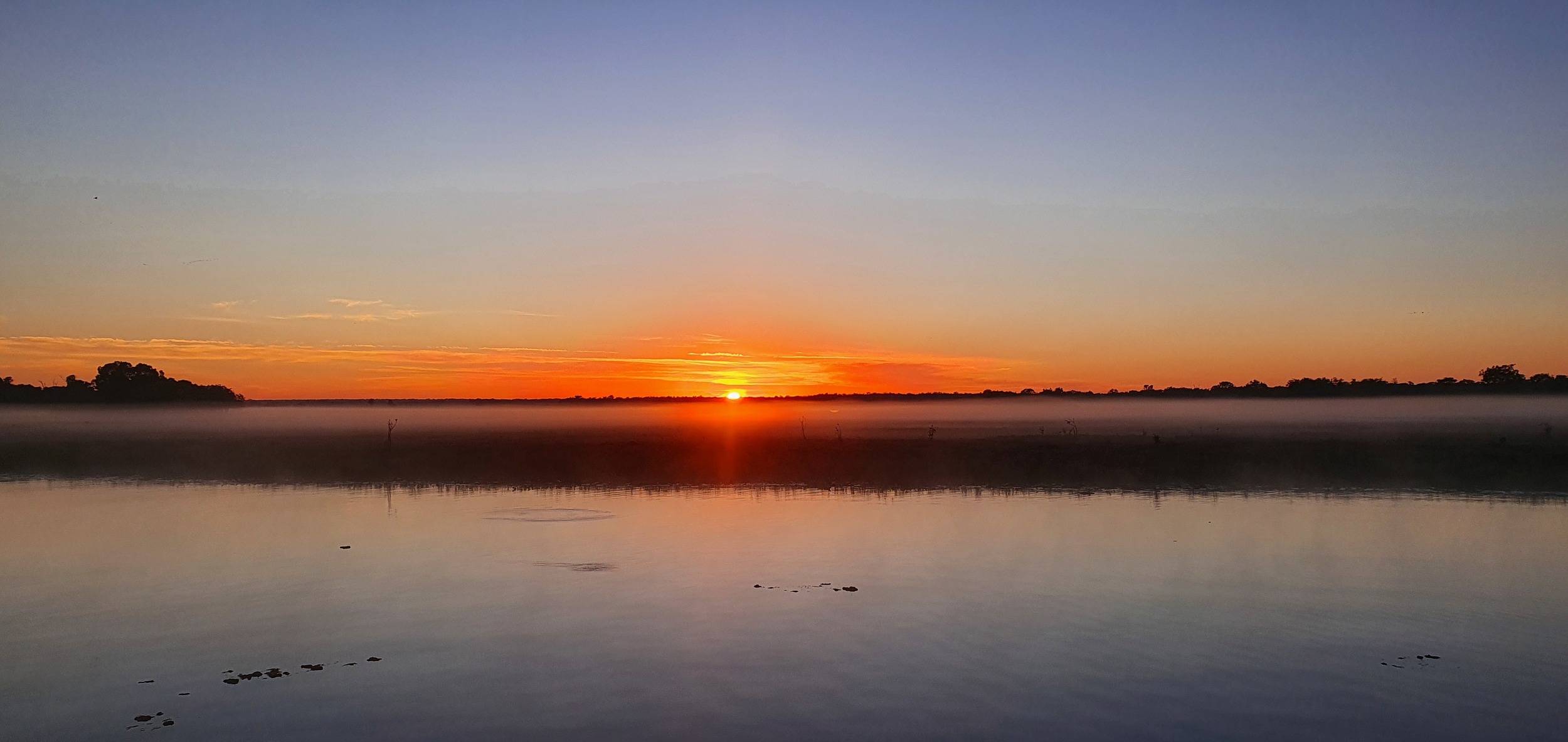
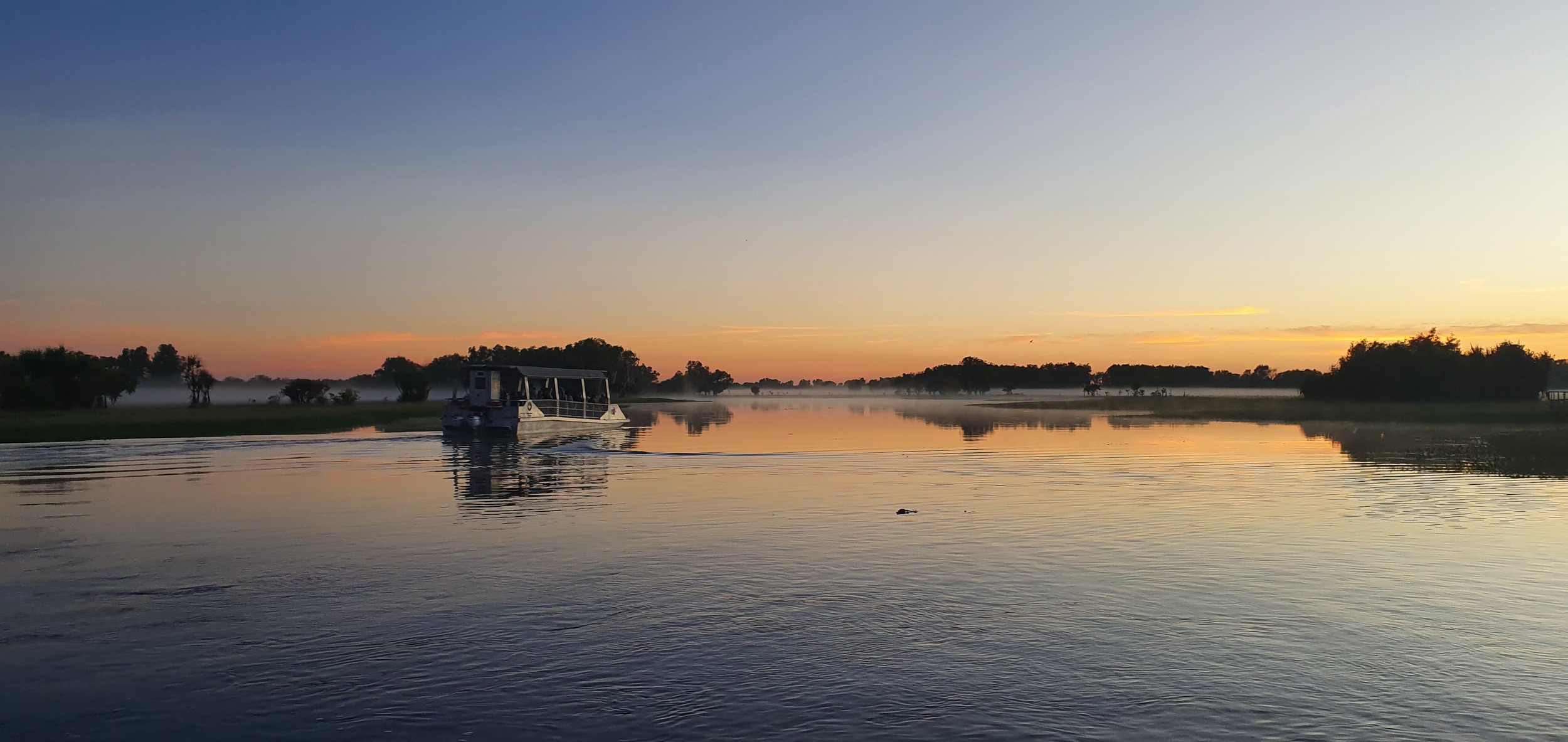
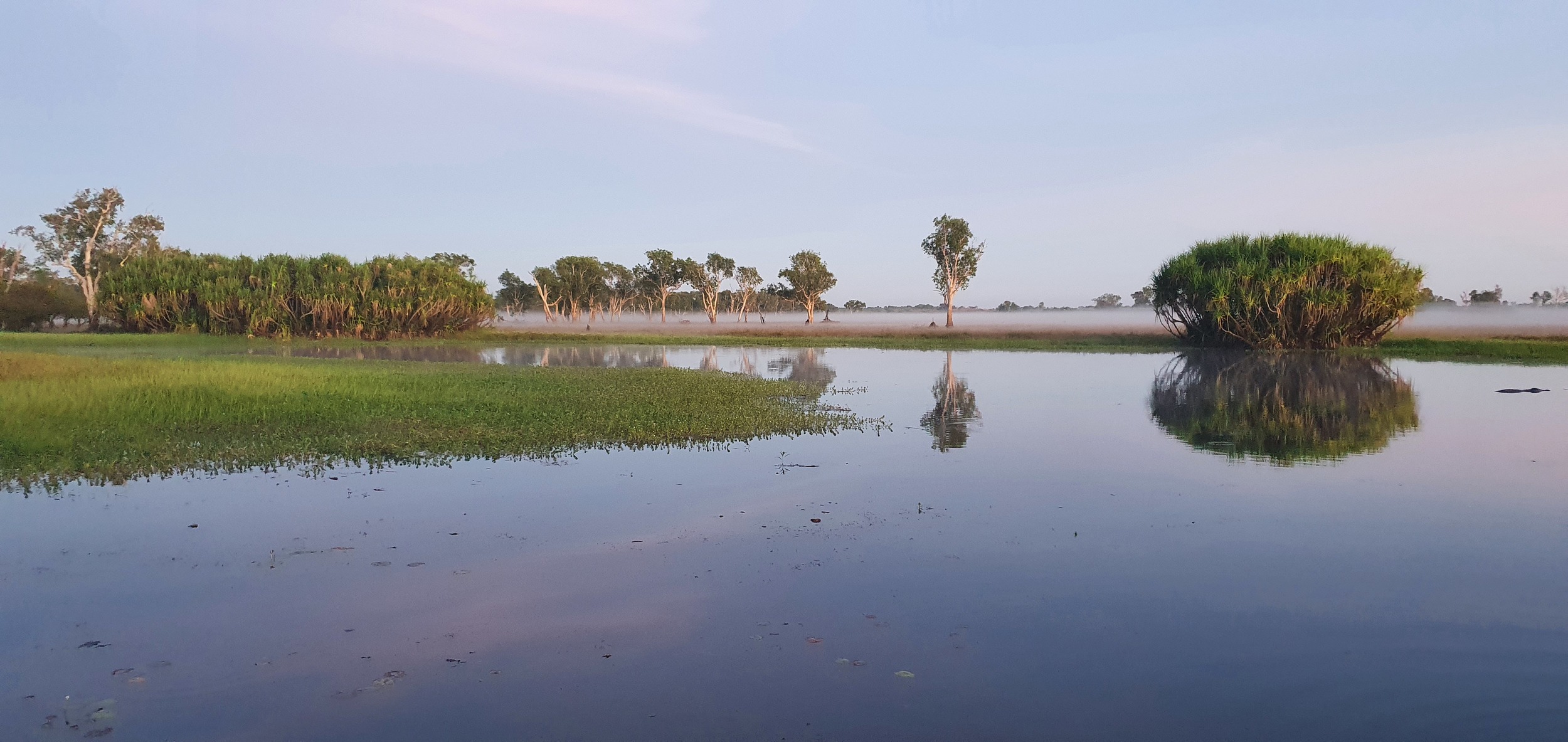
It was a fantastic experience, living up to billing, though we failed to see either of the unlikely but key targets I had for here, Little Kingfisher and Great-billed heron (both potential Australian ticks, but not lifers). Nevertheless a highlight for me was getting up-close-and-personal with Jabiru (Black-necked Stork), my first in Australia of this iconic northern bird.
Of course we also saw several crocs including one very big male, as well as Buffalo. Literally thousands of Plumed Whistling Ducks lined the edges of the waterway. Other avian highlights included Brolga, lovely close views of Jacana, White-bellied Sea-eagle, and Azure Kingfisher. As we were watching the latter, Paul called to me that he was onto a potential Bar-breasted Honeyeater. I lurched over to his side of the boat in time to find it in a tree top and note the key features, just in time for it to disappear, not to be seen again. When this happens with lifers it is extremely disappointing, and especially so this morning because we had been doing poorly with overall with the top end Honeyeaters.
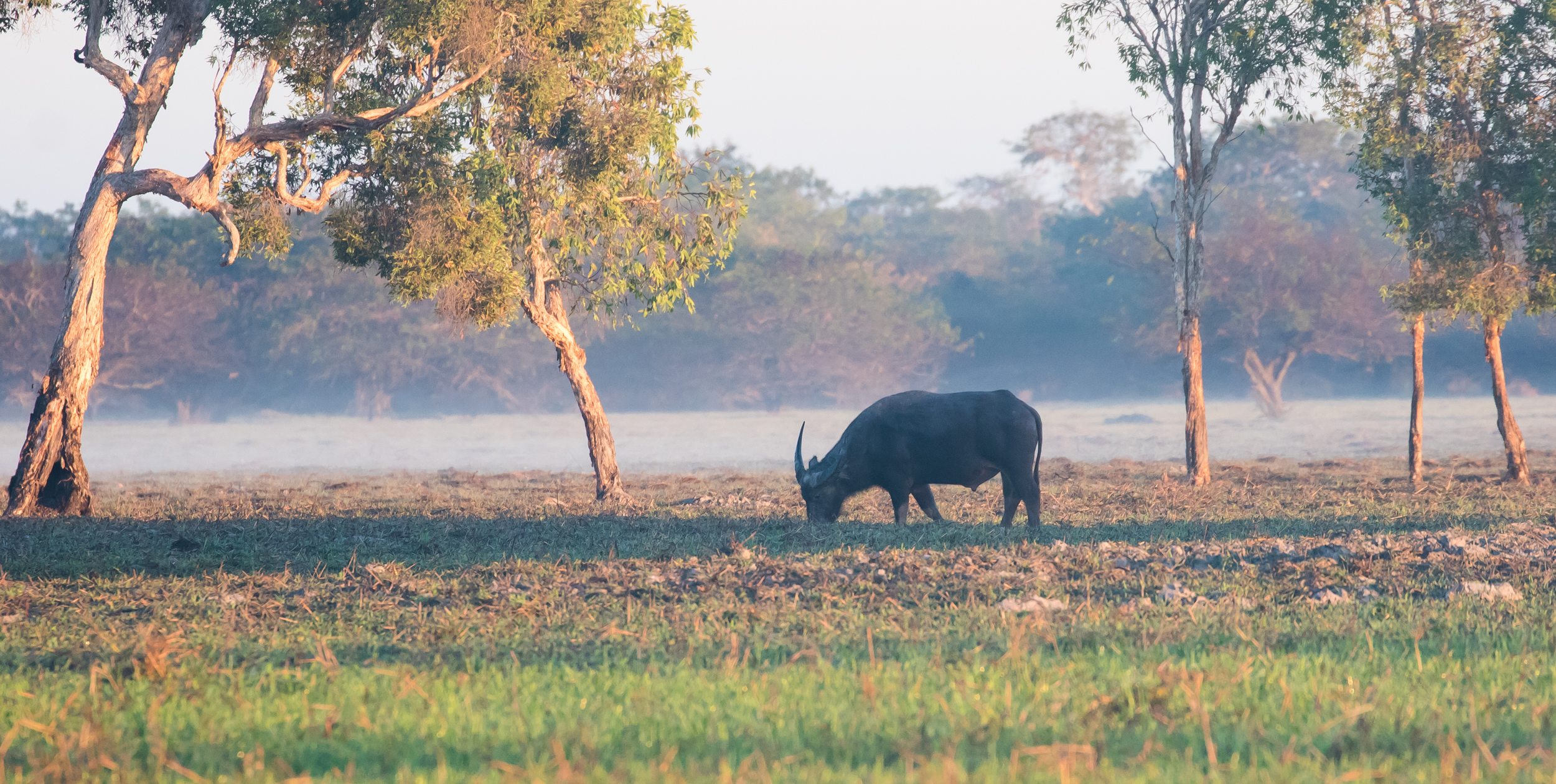
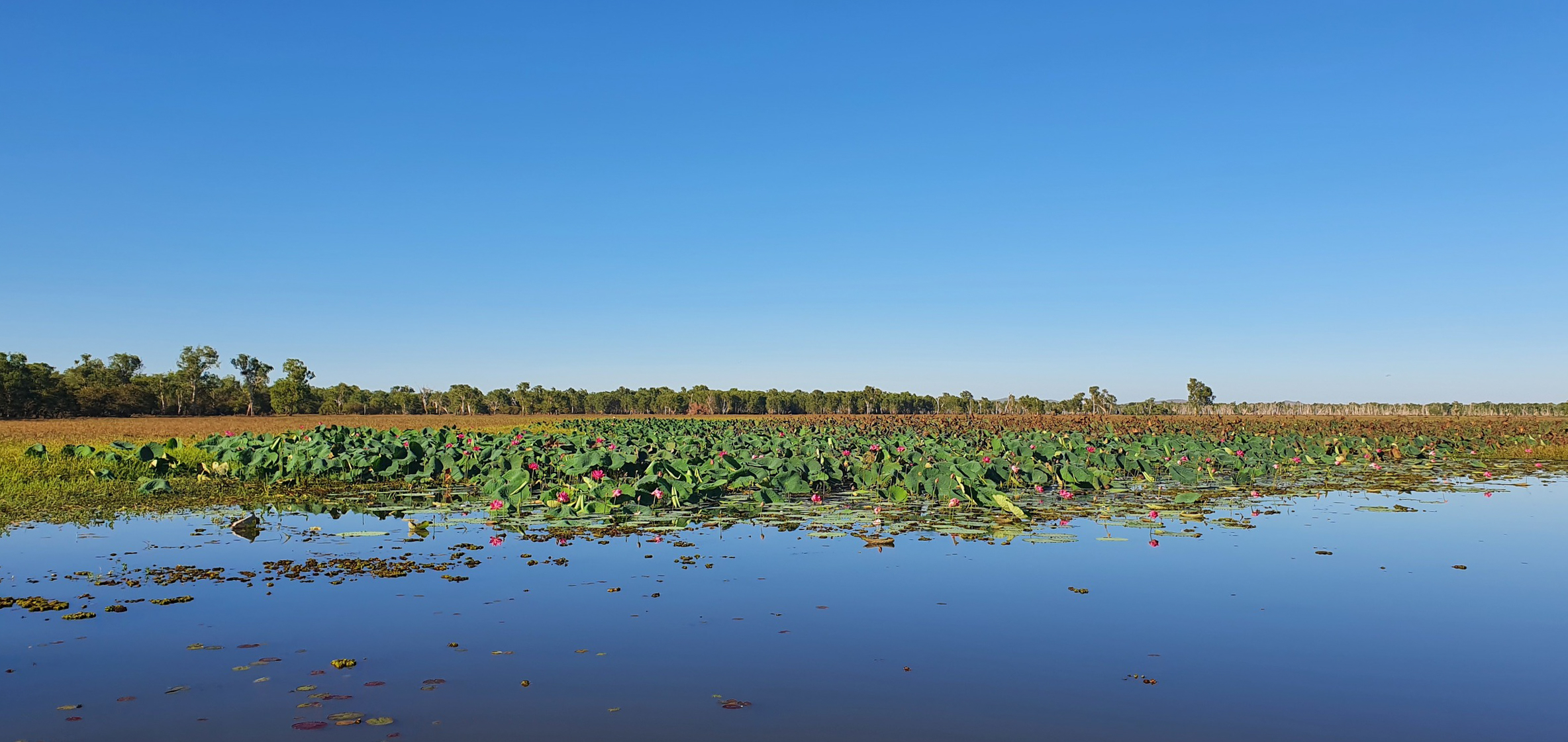






After the boat ride we drove back to Nourlangie Rock, another spectacular local site. I found Kakadu to be a curious place, isolated places of incredible natural and spiritual beauty separated by endless kms of unattractive savannah of scraggy half-dead looking trees and dry grass, often with burnt understorey. Undoubtedly important habitat, but not much to look at compared with spots like Ubirr, Nourlangie and the various billabongs.
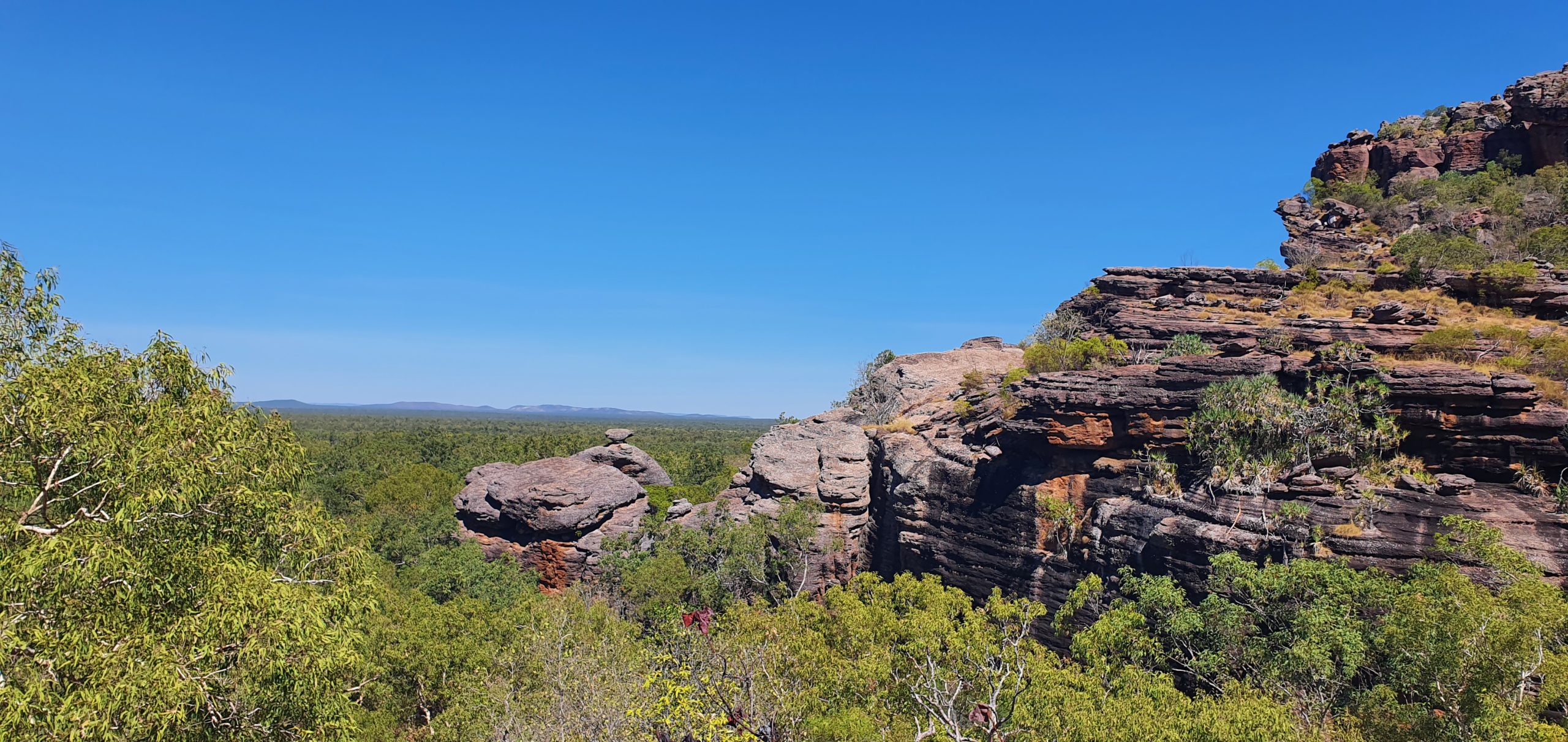
In the carpark we bumped into Stuart Hull, fellow SA birder and known to me primarily as the berley-master on Port Mac pelagics. He was on his own NT trip having driven from SA setting out a couple of weeks ago. After catching up with him we walked the trail that leads along the base of the rock and into a shady moist gully. We still needed three sandstone specialties but the only one we found this morning was White-lined Honeyeater. Now split from Kimberley Honeyeater, this fairly plain Meliphaga is a NT endemic! We scanned the rock-face hoping for either Shrike-thrush or more Rock-pigeons but without luck. I did pick up a couple of distant Little Woodswallow, a lifer!
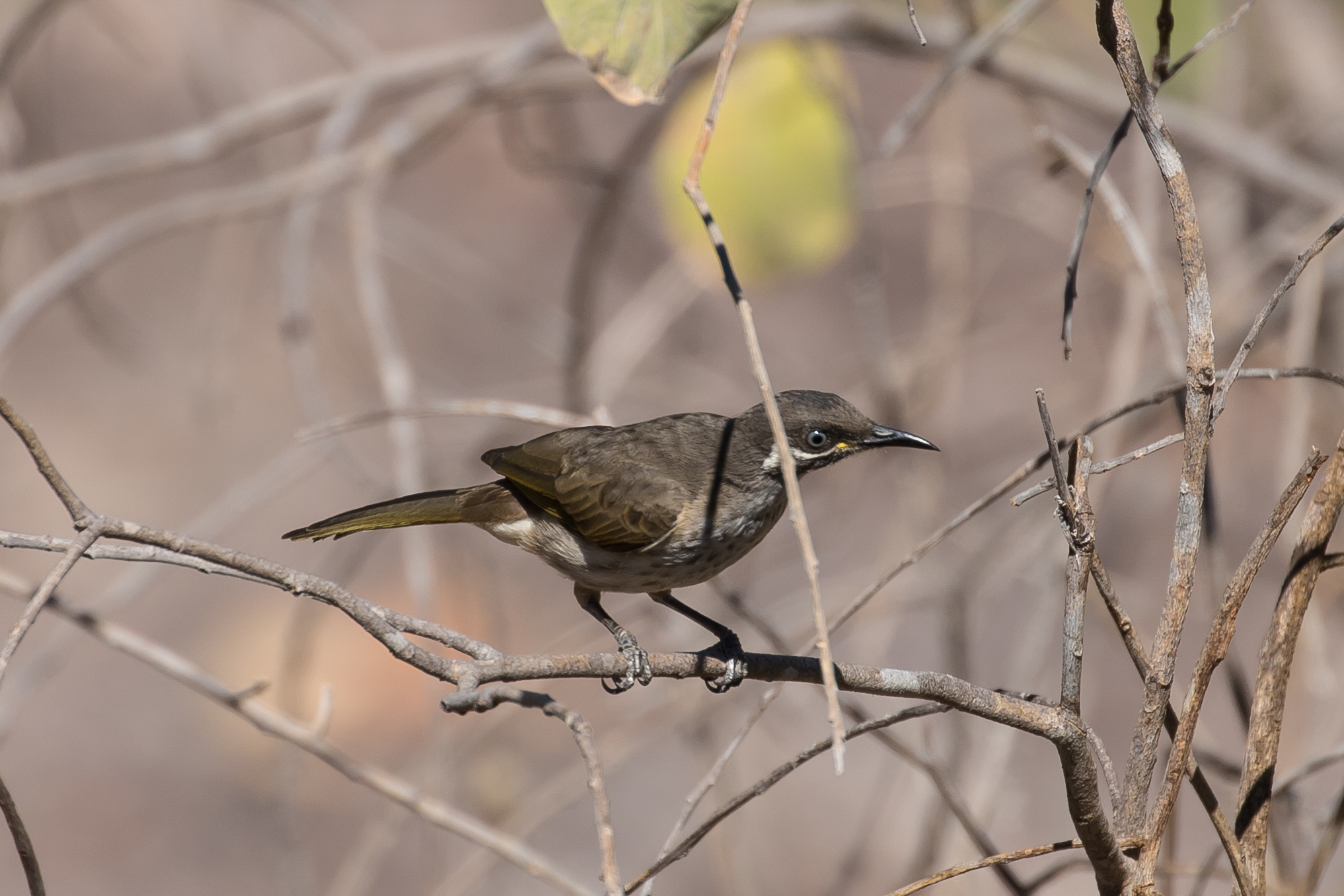
From Nourlangie we detoured to nearby Anbangbang Billabong (another Crocodile Dundee site). A couple of Jabiru were stalking on the far edge and 100s of Wandering Whistling Ducks were resting on the water’s edge as well as several of the other usual suspects at wetlands.
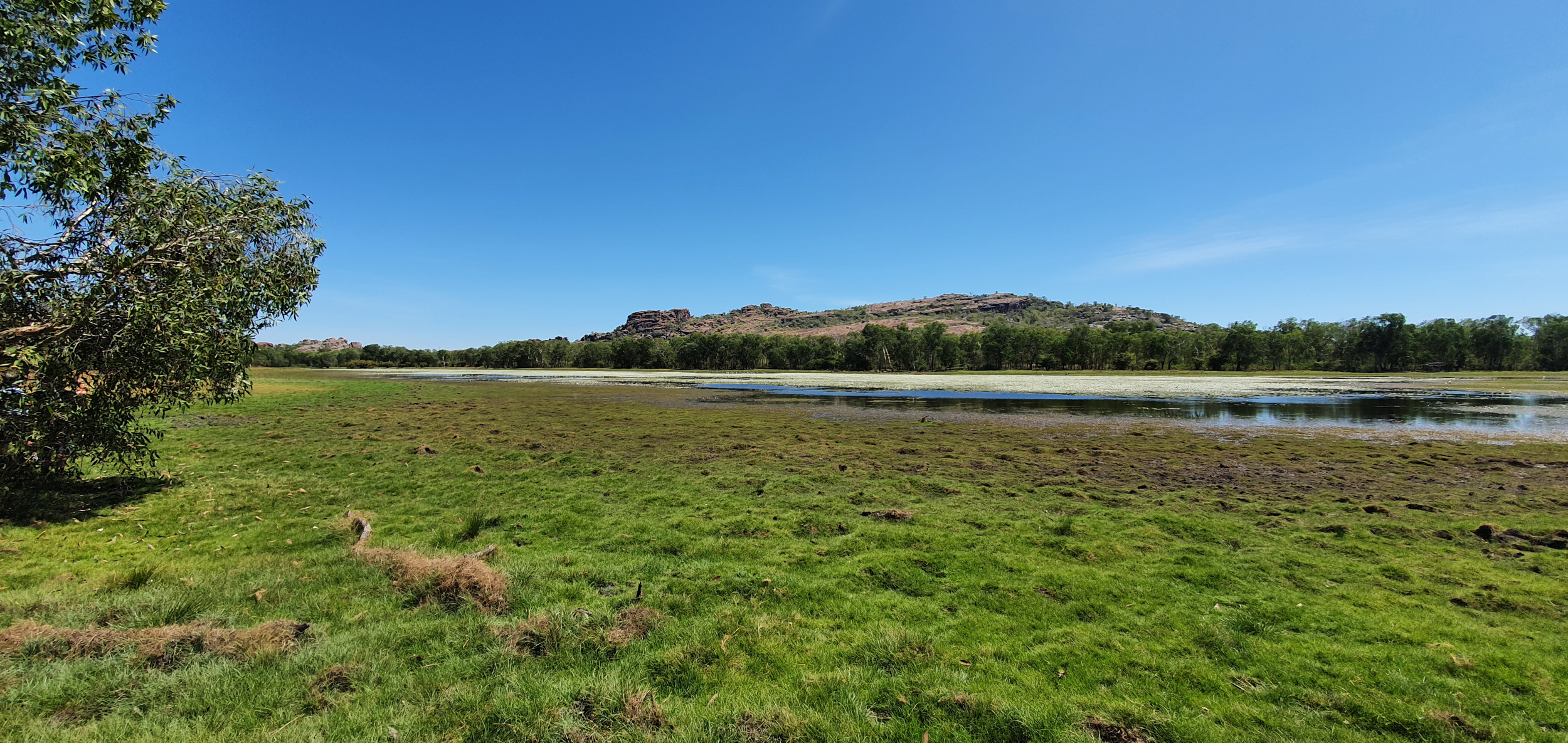
A Brush Cuckoo jumped about in the grass catching caterpillars and worms. We also drove along another track to get to Gubara, another famous rocky outcrop where we hoped for Sandstone Shrike-thrush. At the end of the track it became apparent that to “do” this site would involve a lengthy walk in the midday heat, so we scanned rocks by the carpark and clambered about on some close ones. We heard a Chestnut-quilled Rock-pigeon here, but we could not track it down. More Little Woodswallows and my first Australian Pheasant Coucal were the highlights here and at 13:00 we headed to Jabiru for some lunch.
Jabiru is a god-forsaken place with few redeeming features. The Parks Australia website describes it very generously thus: “Jabiru is the main township in Kakadu National Park. It has all the services you’re likely to need and is a perfect base for exploring the park.” I had imagined this might lend it some charm, perhaps a street with some Indigenous art shops, tourist information and a few restaurants. But actually it was built not for tourism but to support the Ranger Uranium mine built in 1980s and now in the process of closing. There are a couple of hotels, oases in the savannah, but no discernible centre and nowhere we could find for lunch. The words “perfect base to explore” are presumably used in the same way that a town with nothing else to offer is described as “the gateway” to somewhere. One thing going for Jabiru is that it has Optus 4G reception, so we checked out Trip Advisor for where to eat; top recommendation was the social club. But we followed our GPS there to discover it is closed, boarded up and covered in graffiti! Next on the list was the Bowali Visitor Centre where there is a café, a few km out of town. But it was closed for “upgrades”. In the end we made do with sandwiches from the servo and a refreshing icy-pole! While we munched away I fired off some messages to Tom Tarrant to see if he could advise on our best bet for Sandstone Shrike-thrush.
In the heat of the day we decided our next destination would be Mamakula Billabong, about 30km back along the Arnhem Hwy. At the excellent hide we had some nice close encounters with Magpie Goose, Paperbark Flycatcher and Rufous-banded Honeyeater as well as enjoying sitting down in the shade to view for once instead of stomping about in 35 degree heat! A walk through the surrounding grasslands did not yield the hoped-for finches other than around 10 Crimson Finches, and a few Red-backed Fairywren.



By this time Tom had come through with some very promising sounding gen for the Shrike-thrush so we pointed the Forrester back to Border Store / Ubirr and parked up at nearby Bardedjildji where a scenic trail leads for a few km through paperbark woodland, sandstone outliers and pockets of monsoon forest. After a short walk through the bush we came to the first rocks and started scanning. I played the song a few times and all of a sudden I looked up to see a large slim Sandstone Shrike-thrush on top of a rock looking down at me. Paul was nowhere to be seen, having wandered off in a different direction. I called softly at first, then louder as the bird seemed to stay put, and eventually shouted at the top of my voice: “Paul: Where the f*** are you? I’ve got one!”. Finally I could hear footsteps and Paul arrived just in time for it to fly off from its exposed rock-top to somewhere out of sight. Fortunately another burst of playback brought it back to the edge of another nearby outcrop and we both enjoyed great views of this northern sandstone specialist. Three out of four now down, and I texted Tom with a single word message: “Legend!”. In retrospect I should have added an adjective starting with “F”.
It remained very hot so we decided on another walk along the Manngarre Trail near border store. This was very successful, and we found a very cooperative and vociferous Pitta that was much easier to photograph than yesterday’s birds.



We were also able to track down a stunning Rose-crowned Fruit-dove for my lifer!
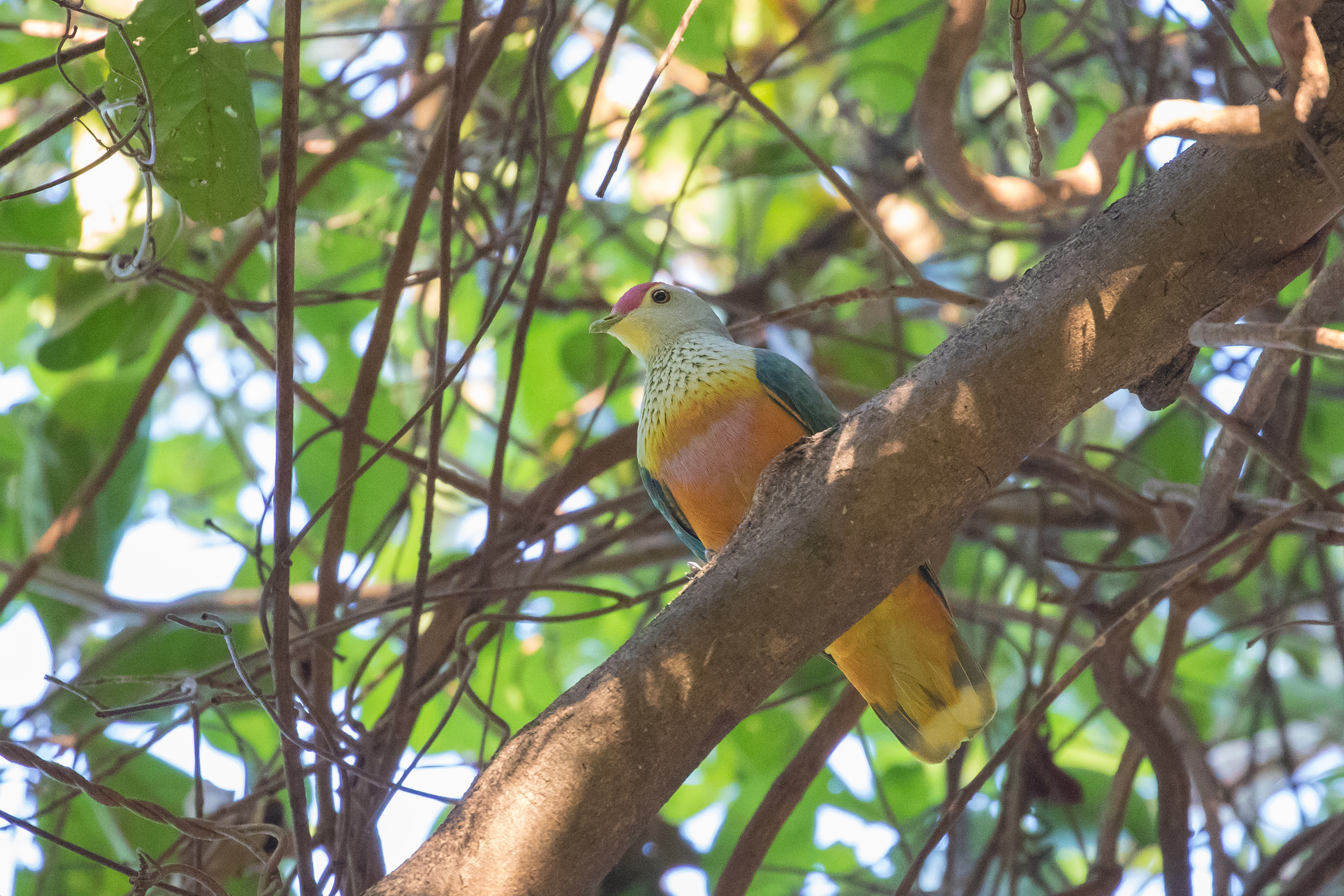
Very satisfied with the day’s birding, and also mindful that yesterday we had tried to cram too much in, we now drove back to Jabiru to the one restaurant, a Thai place called Anbinik where we enjoyed an excellent and very substantial green chicken curry. As we finished off our meals it was getting dark and a Barking Owl started calling. I grabbed torch and bins from the car and strode off in search. Even without the torch I could see a pair of silhouetted outlines on a large palm frond. I warned Paul I was about to turn on the torch and lined up my bins ready for my first ever views of this lovely Ninox (and in the process rectifying a 7 year itch after a heard-only dip in Chiltern). After soaking in this view and feeling smug at how well (how easily) I had found them, I ran back to the car to get my camera but the birds had gone by the time I returned.
We drove carefully in the dark back to Cooinda where we hoped to catch up with Stuart for a beer. We managed beer for sure, but couldn’t find Stuart and turned in early.
Day 5
Starting the day today, the one omission from our four Kakadu sandstone specialists was Banded Fruit-dove. We had a number of sites to try throughout the day, but decided that Nourlangie rock was our best bet and headed there for 7am. A bench above the damp gully provided a good spot with a view into some of the bigger trees, and in 30 minute vigil we were rewarded as at least one Banded Fruit-dove flew into the high tree tops at eye level. I managed to mess up my camera settings (actually by not resetting them from my abortive owl photograph the previous night) so our views were rather better than my record shot would suggest. We enjoyed the view from the top of the loop walk and tracked down our first unequivocal Silver-crowned Friarbirds. A few Red-tailed Black-Cockatoos joined us at the viewing point, and we also heard a Sandstone Shrike-thrush singing from far off, but could not locate it.
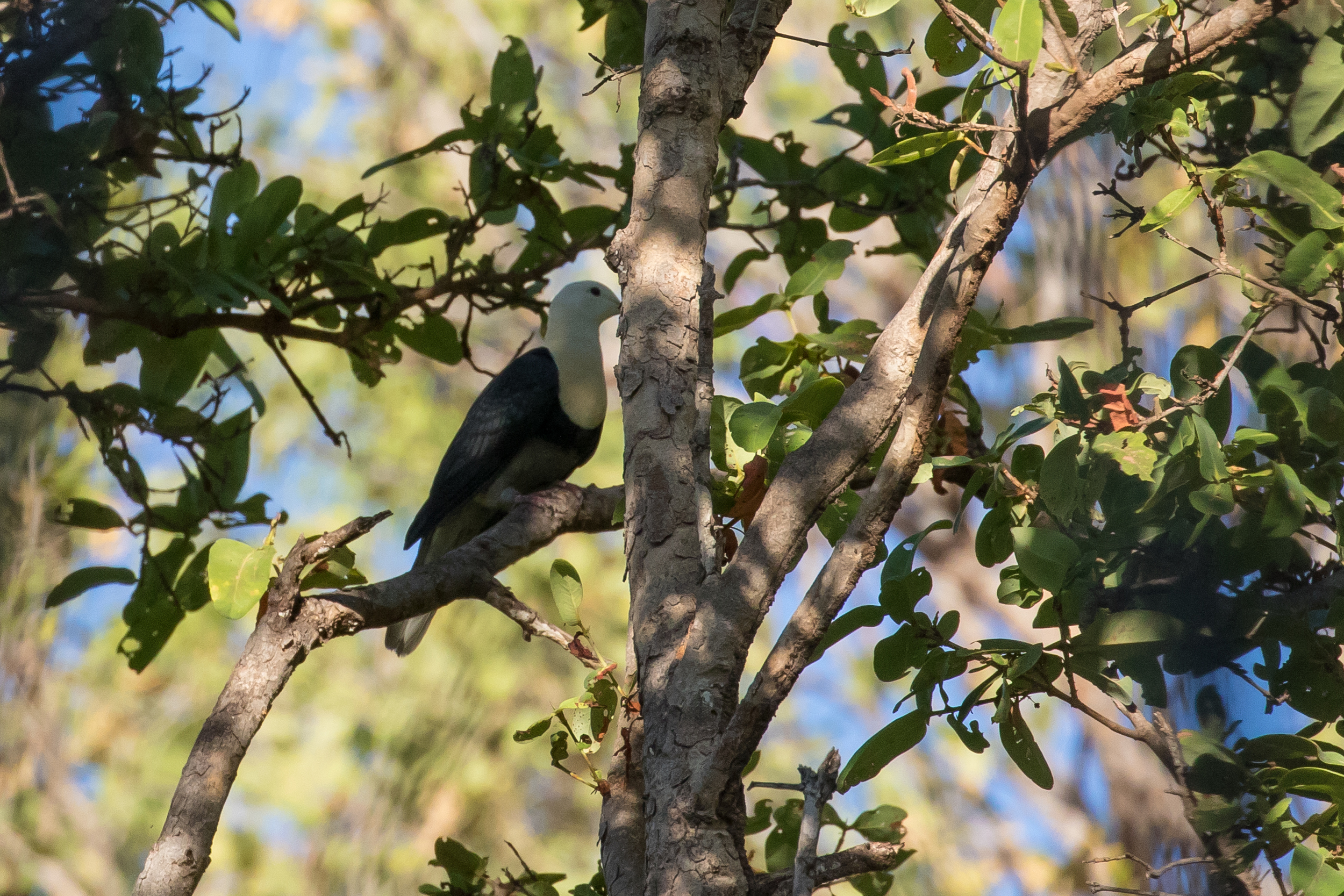
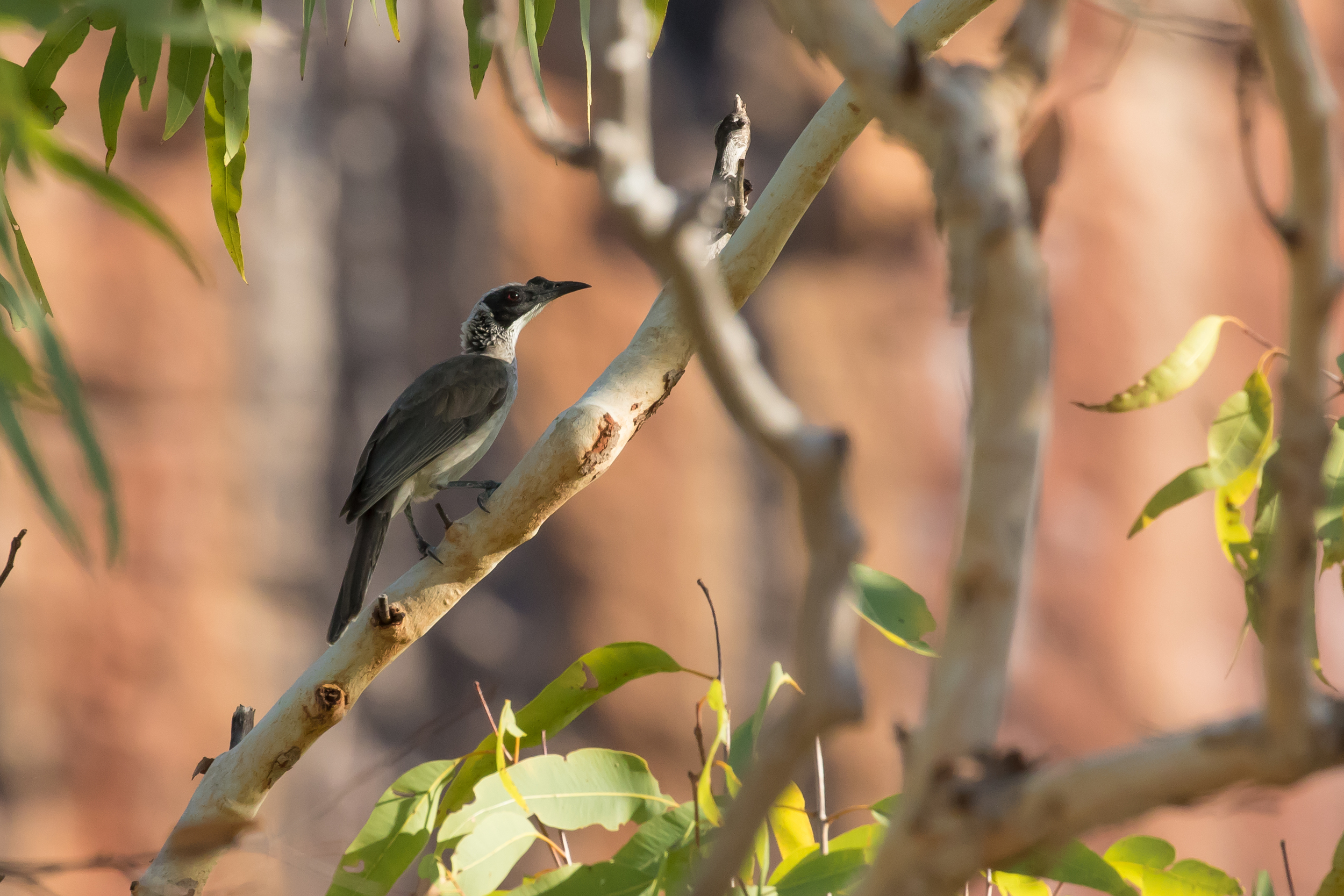
So 4 from 4 of the sandstone specialists in this eastern part of Kakadu and we were feeling pretty smug and pleased with ourselves (and also grateful to our friends and the birding community at large for the intel they had shared).
Back in Cooinda we grabbed a coffee and breakfast before breaking camp. As I waited for Paul to finish off packing his tent away I wandered about behind our spot and found some Red-tailed Blacks and a Shining Flycatcher.
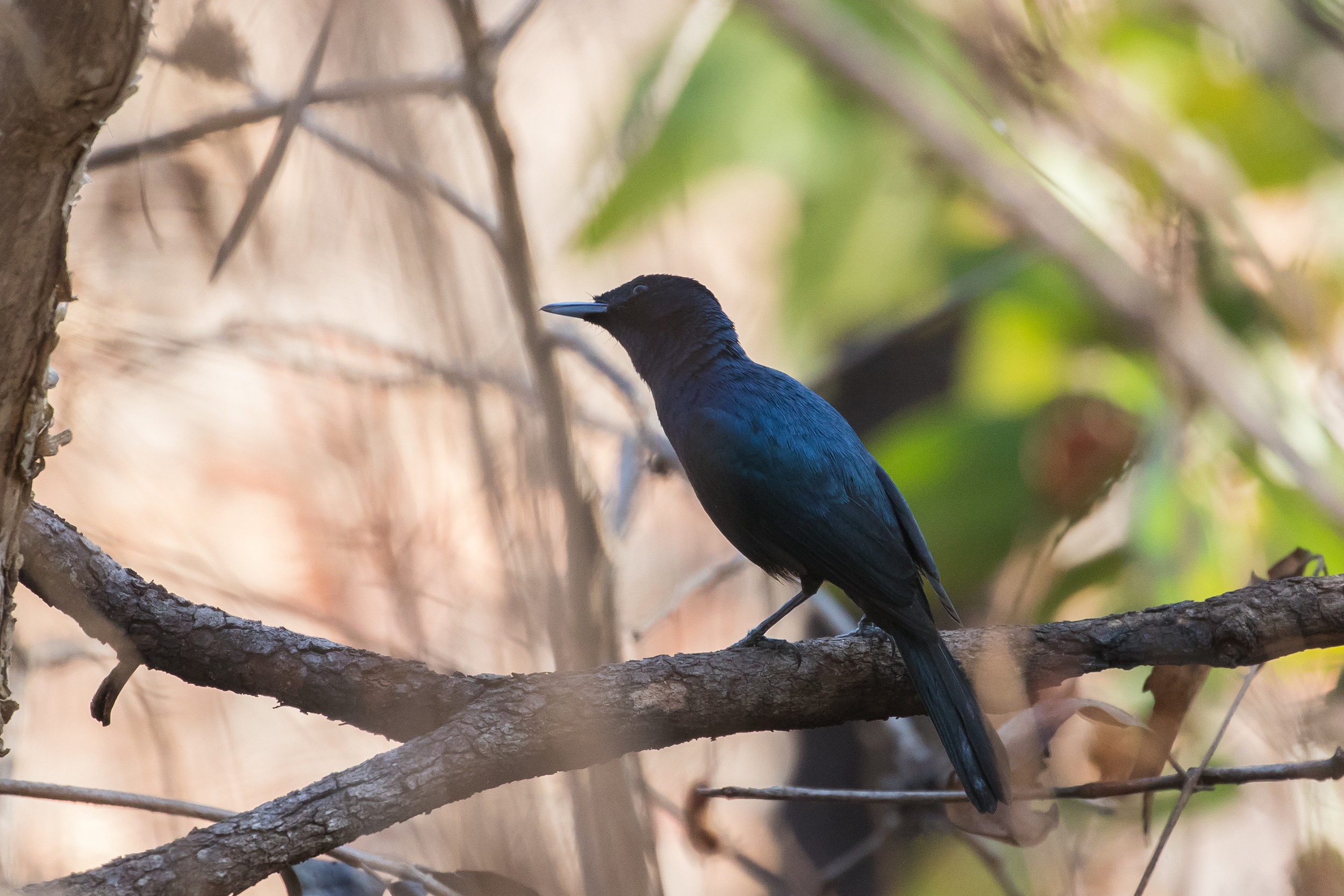
The nearby Mardugal campsite walk passes through paperbark forest to a scenic picnic spot by Jim Jim Creek.
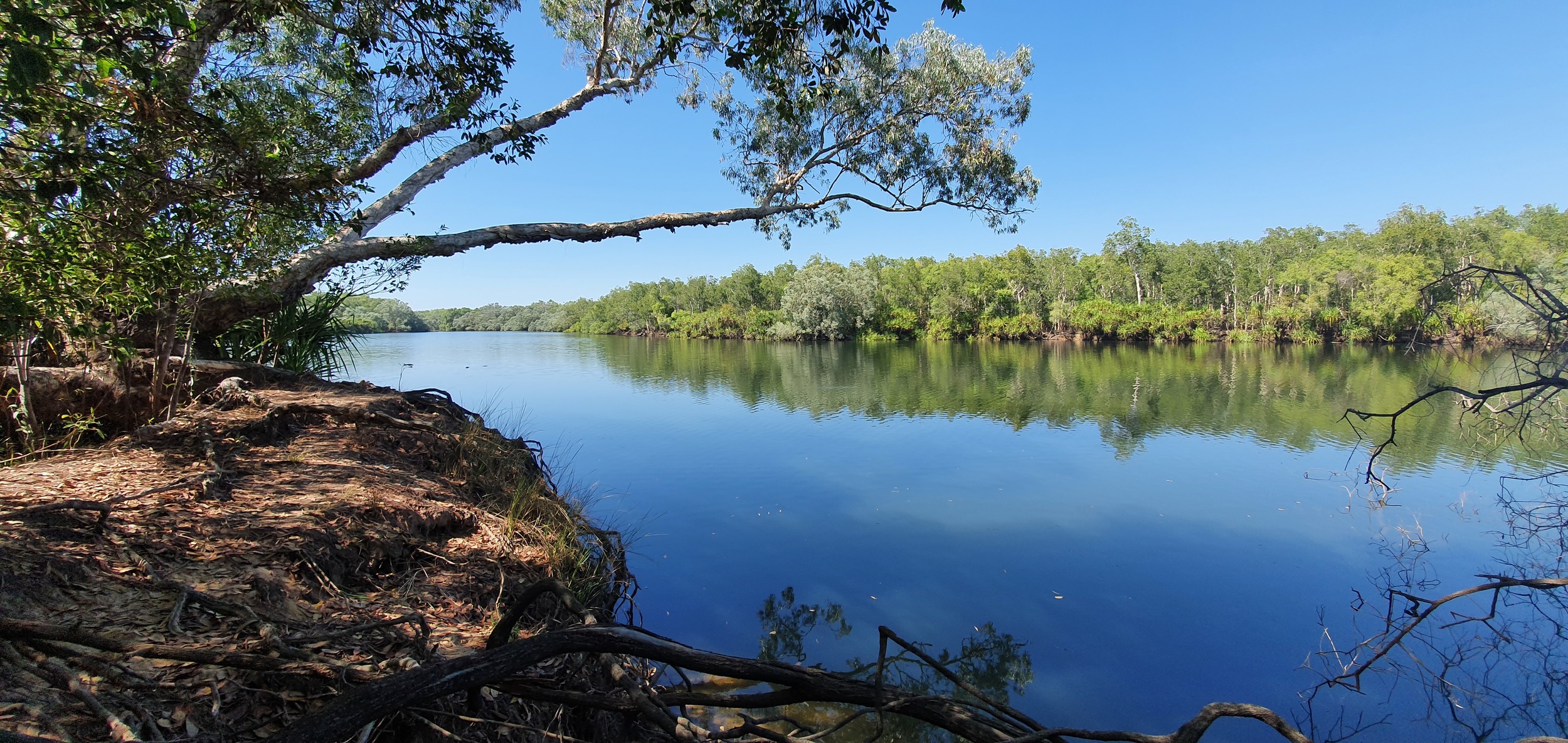
A highlight here was finding another Bar-breasted Honeyeater, this time affording great views and decent photos and making up for the fleeting encounter on the cruise yesterday.
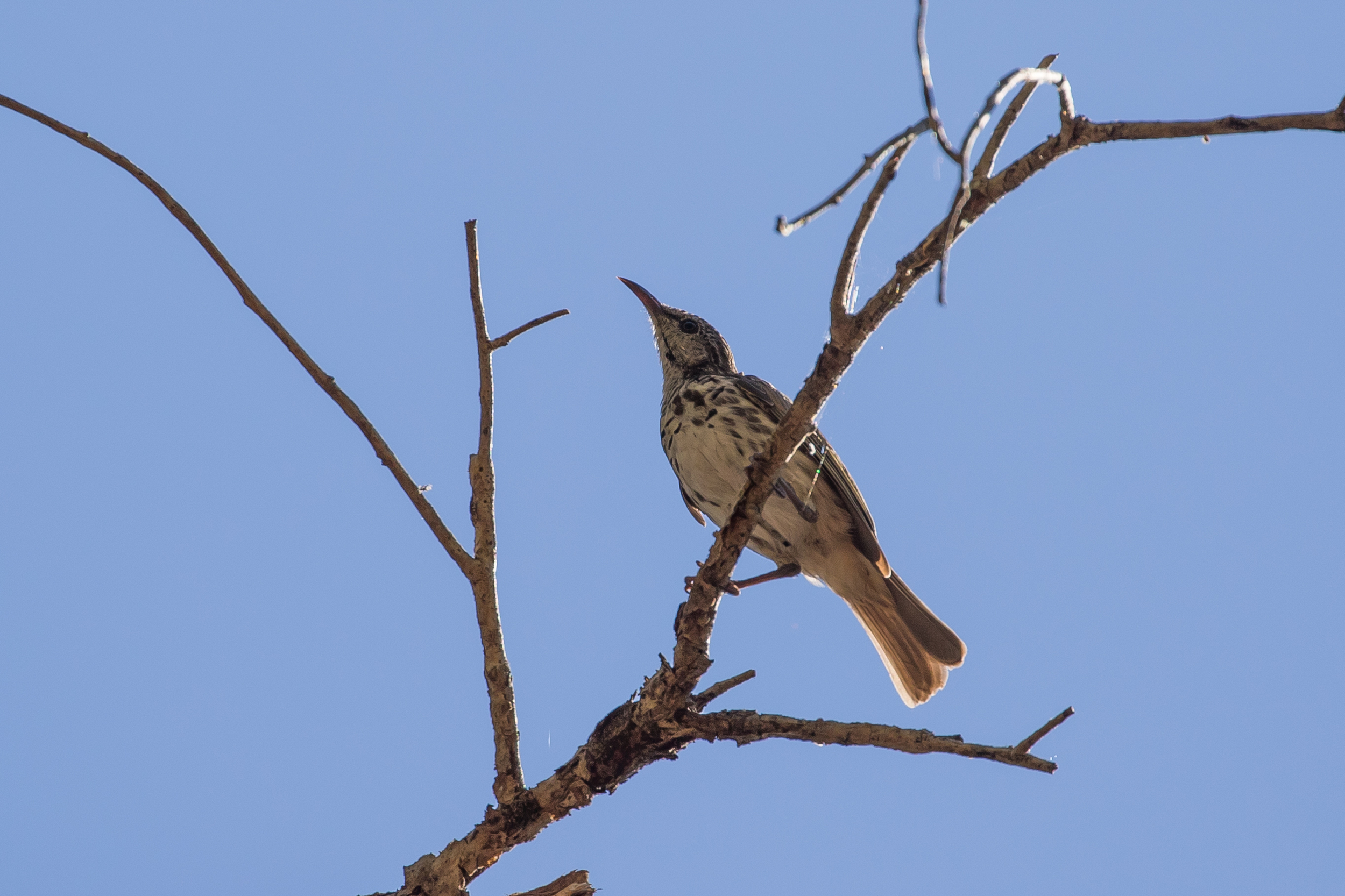
It is around 160km from Cooinda to Pine Creek, our next overnight stop, and we travelled south-west keeping our eyes peeled for raptors (this stretch of road seemed to be our best bet for Red Goshawk, though ultimately we were unsuccessful) and stopping at various creek crossings, per Dolby. Our most productive stop came at Gerowie Creek, where we managed to find a stunning pair of Buff-sided Robin. Marc had tipped us off about this as a possible BSR site, but we were close to giving up after hearing nothing and getting zero response to playback. Clearly, however, the tape had brought them in silently to check us out.
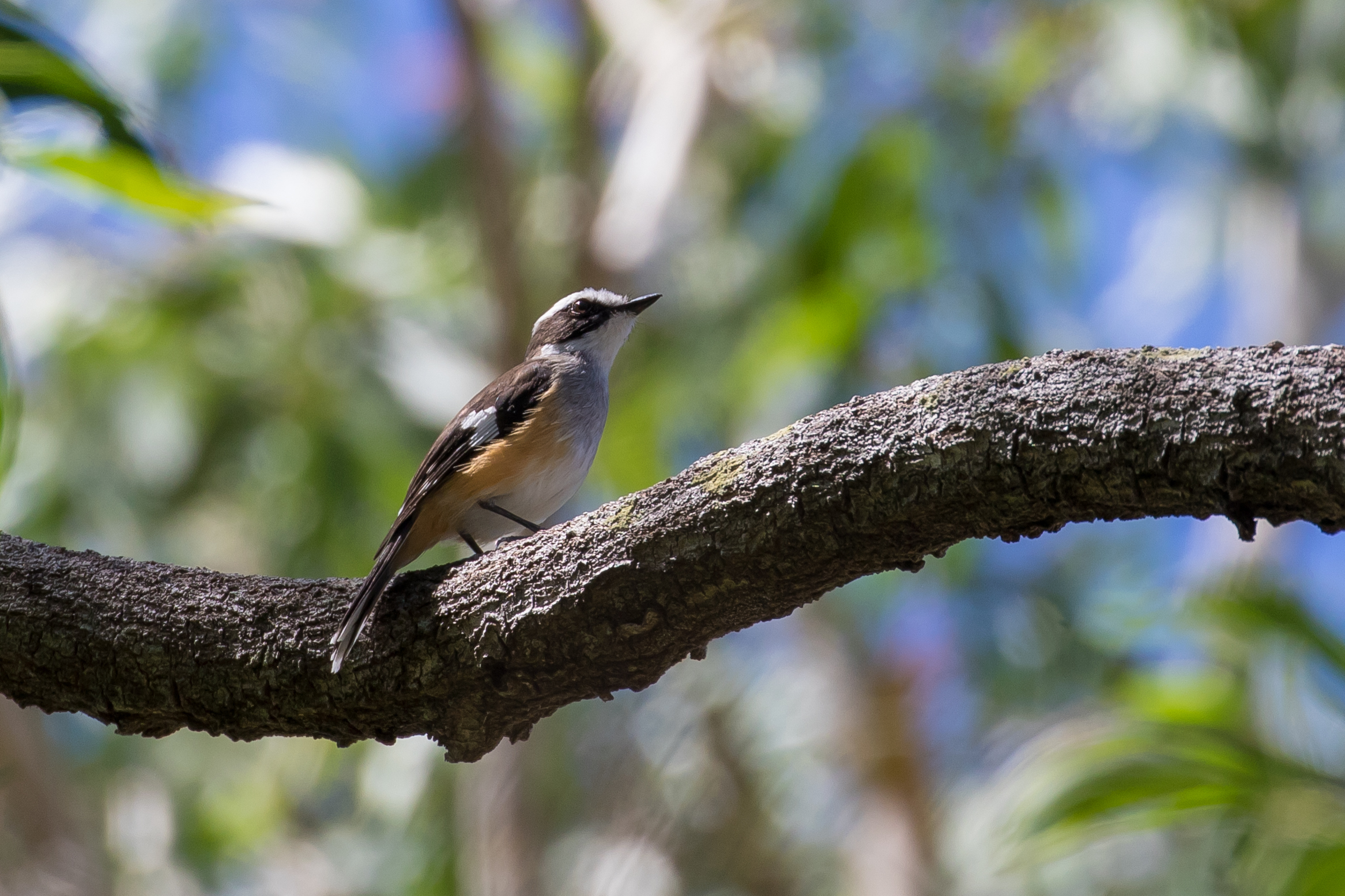
About 500m before Mary River Ranger Station we stopped by the water tower to check out a couple of tip-offs. One was that sometimes Red Gos sometimes roost on the tower. But not today, sadly. The other bit of gen was bang-on though, and we found 3-4 Northern Rosellas sheltering from the harsh midday sun under the water tank atop the tower. A Silver-backed Butcherbird was hopping around the car-park at the ranger station itself, and a quick walk through the savannah here yielded a few Little Friarbirds and Blue-faced Honeyeaters.
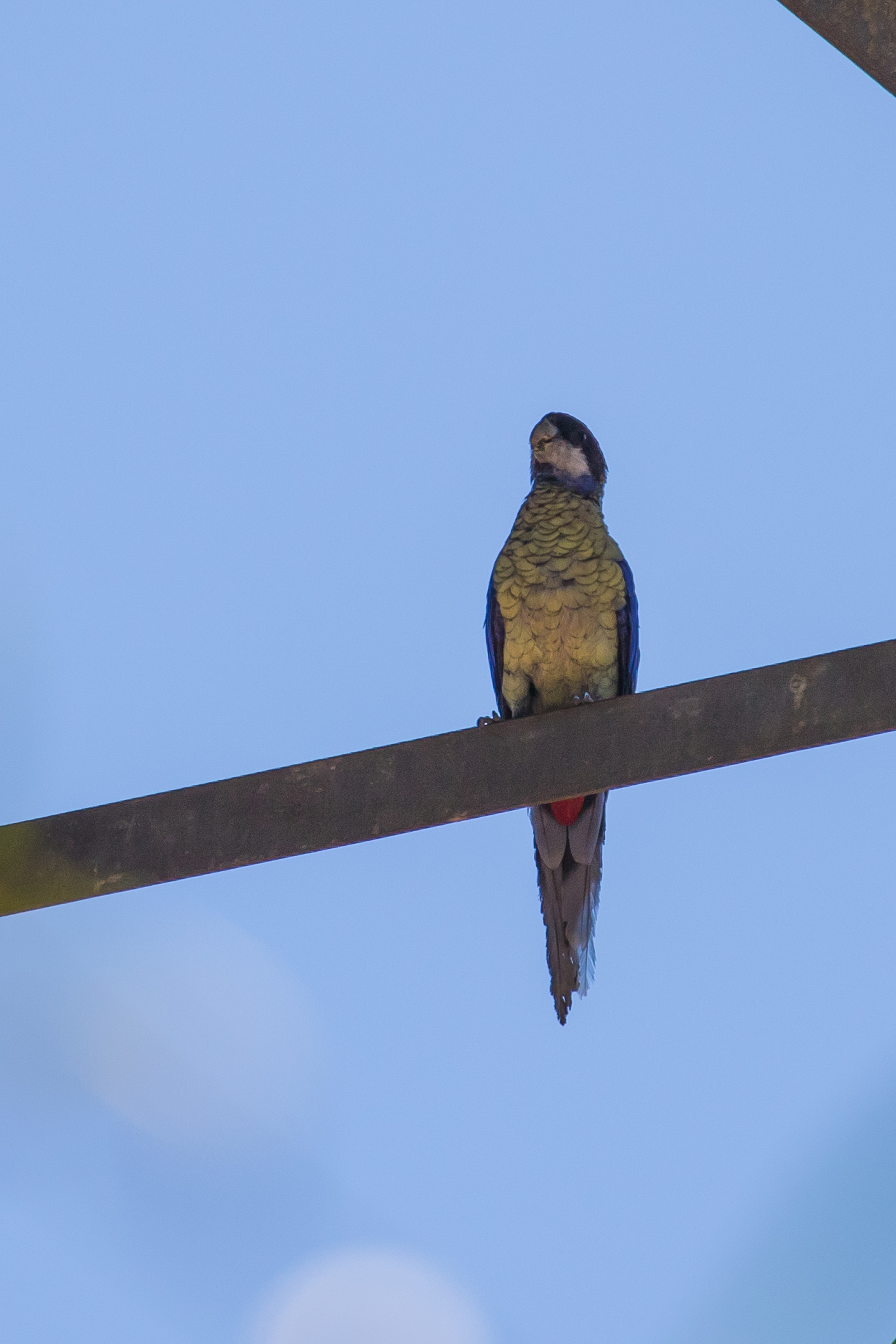
We’d hoped to have lunch at the Mary River Roadhouse, just 10km further on, but the roadhouse was closed, another victim of the pandemic. I had some fruit and some cheesy bread I’d picked up at a Darwin supermarket in case of emergency so we made do with that while sitting in the shade outside. A couple of Northern Rosellas were enjoying a shower under sprinkler in the deserted campground, and three Great Bowerbirds scuttled about the carpark.
Though we continued our raptor scanning, we didn’t stop for birding until we reached Pine Creek at about 1530. As I set my tent in the campground behind the pub, my attention was drawn by an unfamiliar gentle twittering and I found a young Hooded Parrot feeding in the tree above my tent. If only all target birds would be so obliging! A walk through the water gardens in front of the pub in the centre of the town yielded a few more Hoodies, including my first smart male, and we also enjoyed some quiet moments watching various honeyeaters – Blue-faced, White-throated and Rufous-throated – in the ponds that give the gardens their name.



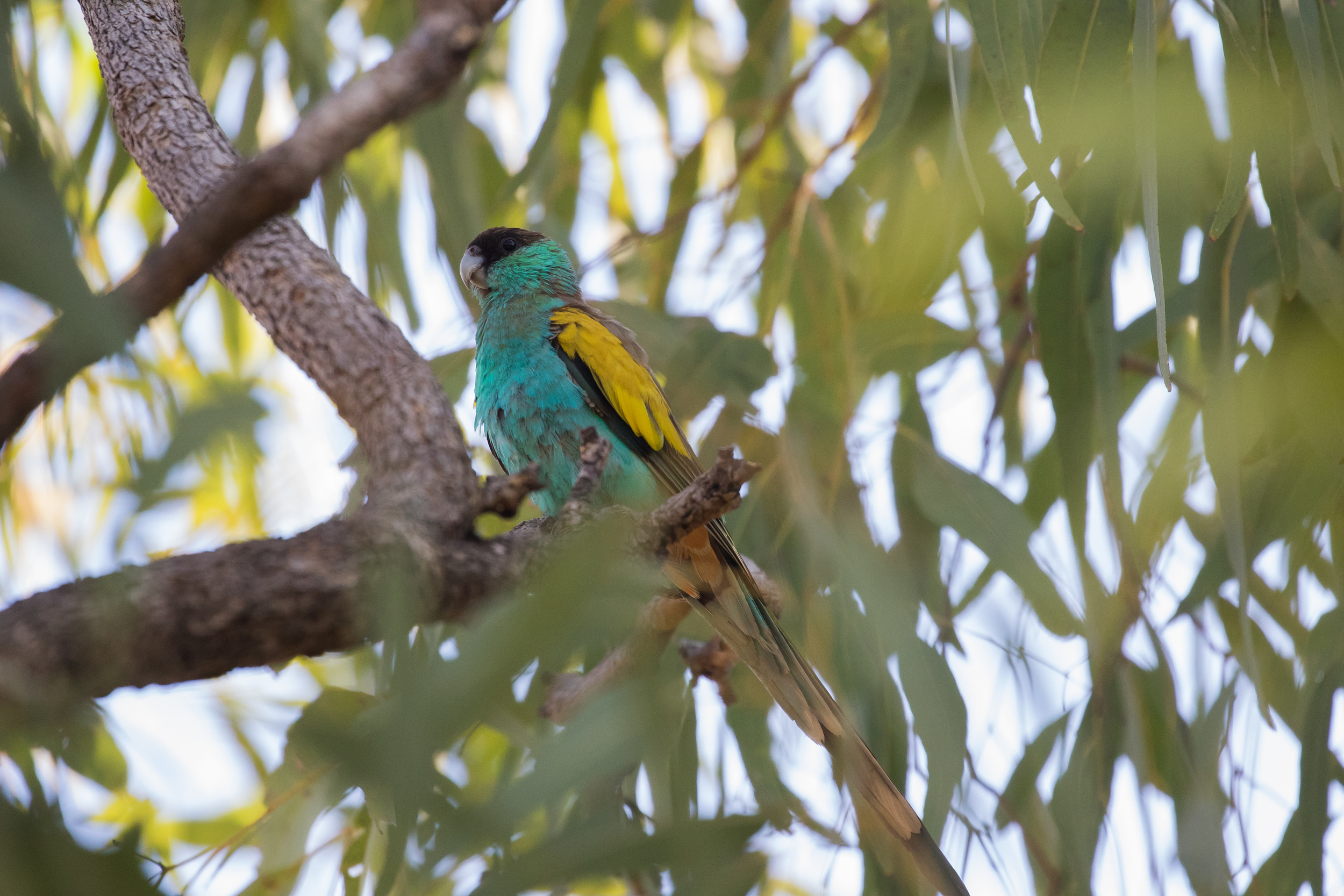
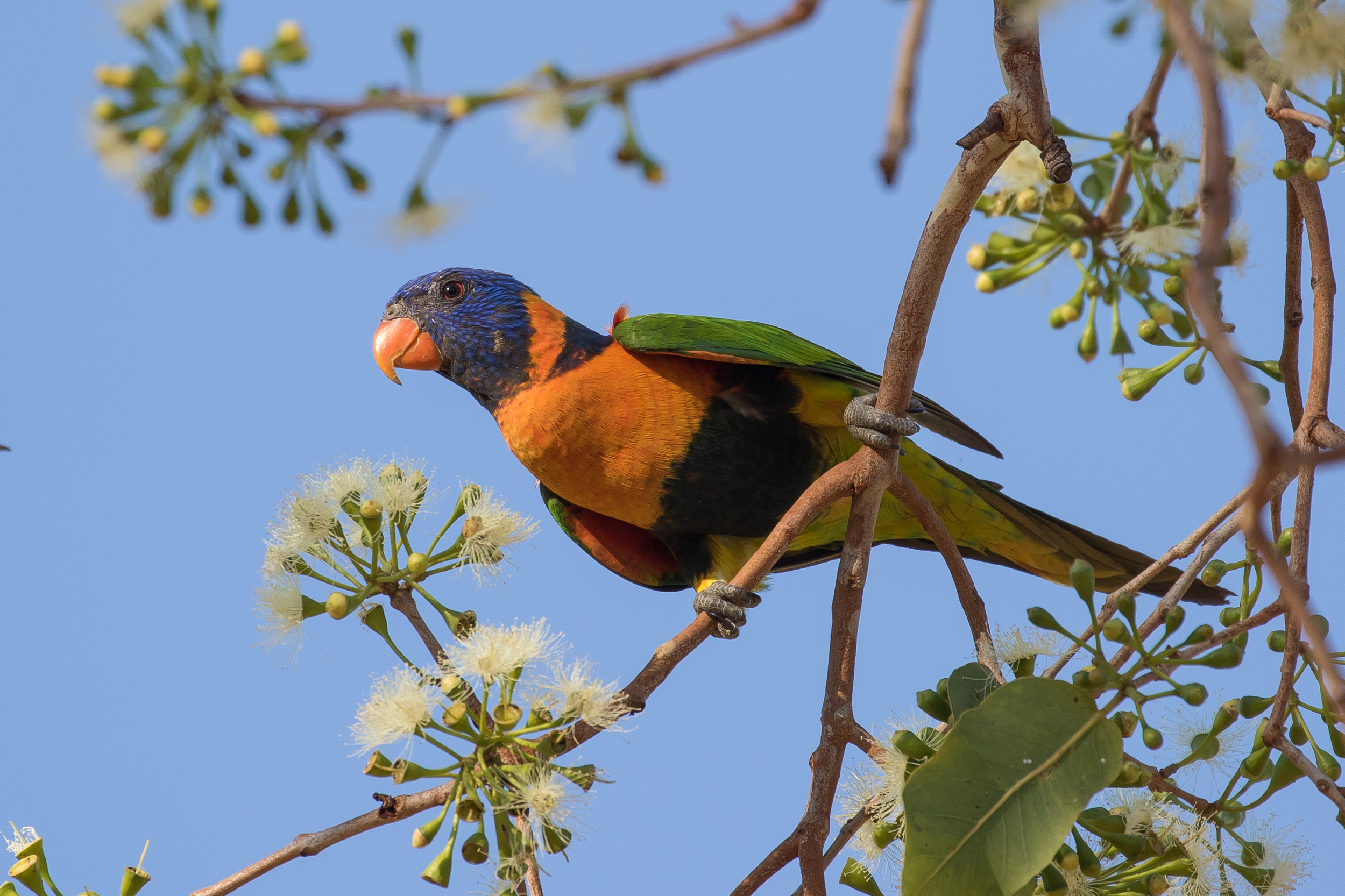
A visit to the sewage works and cemetery (somewhat bizarrely right next to each other) hoping for finches failed to produce finches but bolstered the trip list with Black-fronted Dotterel and Pied Stilt. Paul recognised a vaguely familiar squawky whistle as Cocktiel and we tracked down a flock of around 20 of these lovely outback parrots.



We failed to find any more Hoodies at known evening roost sites like the Enterprise Mine lookout and the nearby town water tower, but as we drove back into town we found several on wires and on the grass of the water gardens in the evening light.




After sunset Paul directed us back up Chinatown Rd where he had gen that Ghost Bats – Australia’s largest true bat species – leave their day roosts in a couple of old mine shafts. I’d expected a spectacle like the one at Naracoort where bats emerge in such numbers that it looks like small clouds of smoke drifting up into the air. We didn’t see a mass exodus from the mine shafts, but well after dark we were able to pick out several hawking Ghost Bats in the torch light. Back at the Lazy Lizard resort in Pine Creek we settled in for a decent pizza and of course a few beers in the western-themed bar.
Day 6
Honeyeaters were not the only family with which we had been “underperforming” in the first half of the trip. The other – more important one – was the finches. I started the trip needing six lifer finches/munias and a further two potential Australian ticks. The lifer targets included Gouldian Finch, arguably the best looking and most desirable of the family in the world! It features, for instance, in Chandler and Couzens “100 Birds to See in Your Lifetime” at number 14 (incidentally I have now seen 53 of their excellent, if very subjective, choices). By day 6 we had seen only Double-barred in a few places (lovely but not “needed”), Crimson (Australian tick) and Chestnut-breasted Mannikin (Aus tick). All six lifer targets remained, so today was set to be finch day with a lot at stake. We started early to make sure we arrived at the Edith Falls Rd at Dead Woman’s Creek at 7am as prescribed.
Small trails through the long grass, made by previous birding visits, were a sure sign we had found the right place. We found some secluded spots from which to view the small remnant pools of fresh water, but they were worryingly devoid of birds, and there was little sign there were any waiting to come down to drink. After a while I walked a bit further down the creek in search of alternative, less watched spots but found only one further pool which was similarly quiet. Back at our original spot we were joined by NSW birder/photographer Chris Nixon who’d been here yesterday. He’d had a variety of finches, but it had been similarly quiet between 7 and 8 and he’d seen his birds later in the day, after 11am! In 30mins we observed one Bar-shouldered Dove, one Blue-winged Kookaburra and one Paperbark Flycatcher.
We decided to join Chris back up the road at a drying pool by the railway crossing where he’d also had finches yesterday. This was quite a good call because within minutes a Masked Finch had flown over our heads, into bushes, then down to the water’s edge. Soon after I had my first Long-tailed Finch, surely a contender for best looking of the family if it weren’t for Gouldian. In all we observed about 10 of each, along with a similar number of Double-barred and several of the usual suspects like Rainbow Bee-eaters, Blue-winged Kookaburra and White-breasted Woodswallow.
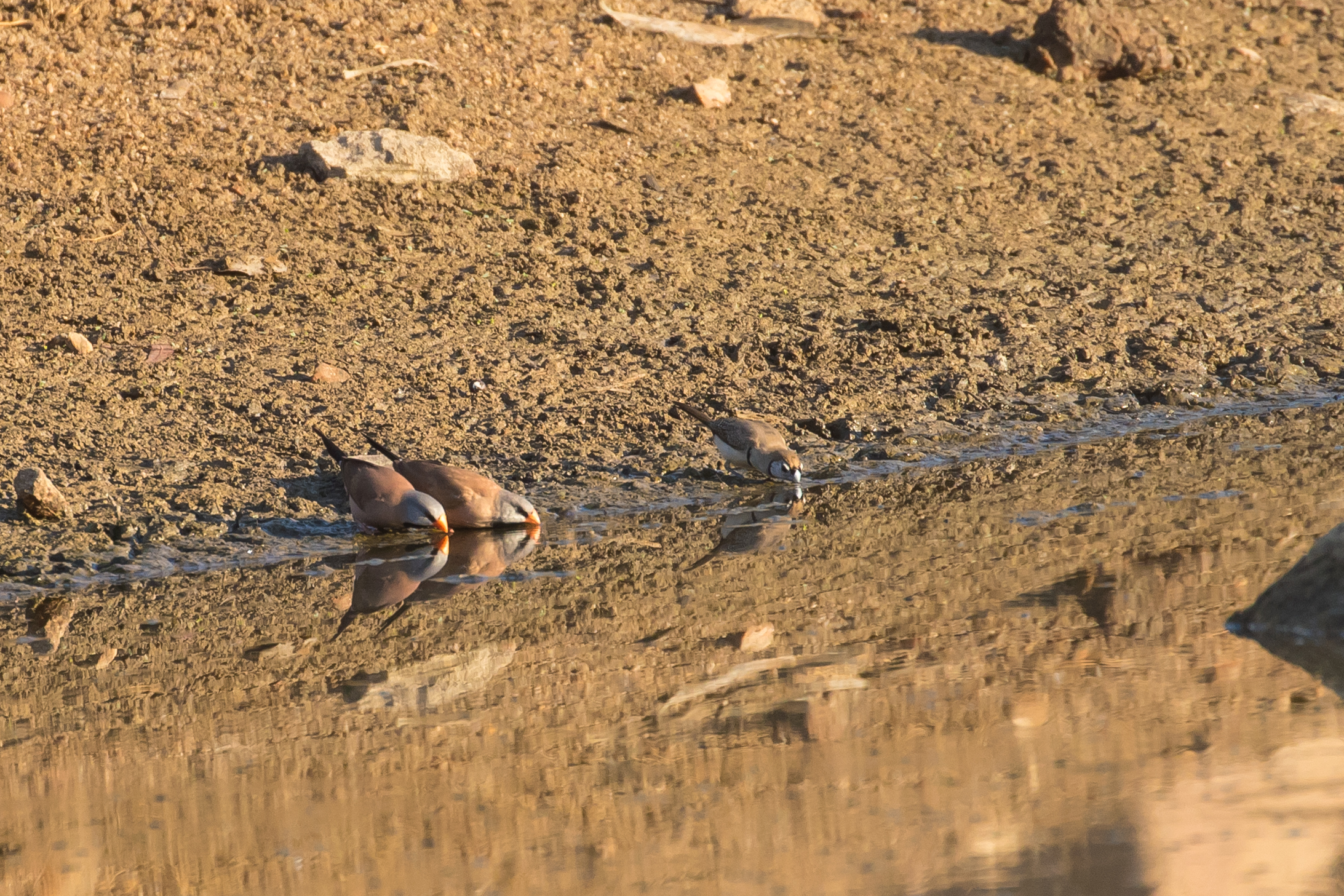
Back at the “main” stakeout on Dead Woman’s Creek we observed a few Masked and Long-tailed Finches along with some Red-tailed Black-cockatoos which came down to drink, but nothing new and no great numbers.
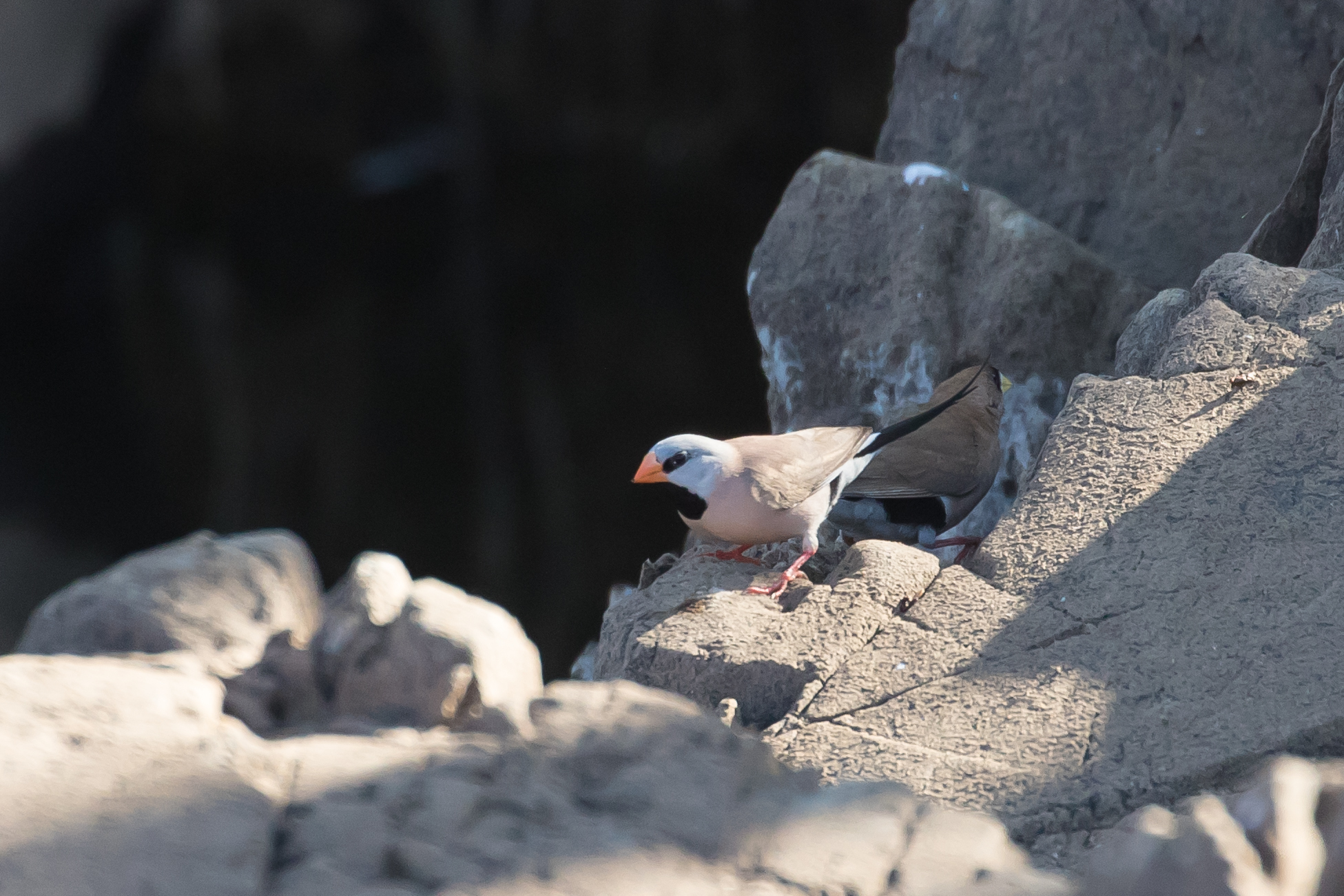
By 9:30 we gave up and trundled the half hour back up Stuart Hwy to Pine Creek to pack our tents away. As we drove north I noted two very large, long-necked browny-grey birds flying on deep powerful wingbeats. My initial thought was Brolga, but these birds were not grey enough, nor did they have trailing legs. we were travelling too fast to stop, but these must have been Australian Bustard, even if we are not sure enough to put a record on ebird.
After a decent coffee and bite to eat at Mayse’s Café we retraced our path south, this time calling in at another spot suggested as a finch stake out in Dolby, Fergusson River crossing. Here we found a nice puddle with finches and honeyeaters coming to drink. We sat quietly on the sand in the shade near the puddle and observed various comings and goings. Several White-throated Honeyeaters gave superb close views and were joined by White-gaped, Rufous-throated and Brown Honeyeaters. About a dozen Masked Finches were also drinking from an unfeasibly small puddle when they were joined by a slightly larger dull grey-green bird. It was a while before I processed what was in front of me and realised this was a juvenile Gouldian Finch: an anticlimactic way to experience a lifer that some have suggested might be the 14th best bird in the world!




The young Gouldian flushed to bushes on the far side of the mostly dry riverbed before Paul could get on it but we were patient enough for it to return so we both got the underwhelming lifer, but our hopes it would be joined by an adult were in vain. By 11:30 we gave up. It was especially gripping to discover later on in the day that had we walked a further 200m up the creek bed we’d have come to a spot that SA birding mate Neil Edwards had found a flock of 40 Gouldians with several adults just the day before!
We gave Dead Woman’s Creek one more shot, walking downstream several hundred metres in the hope of finding a more active puddle – we didn’t – and then staking out another likely spot closer to the road. We saw no Gouldians but there was certainly more activity, with several Long-tailed, Masked and Crimson Finches coming to drink. Even better, we had our first Banded Honeyeater. A couple of this pretty, nomadic honeyeater, in the same family as Black and Pied, were coming to drink.
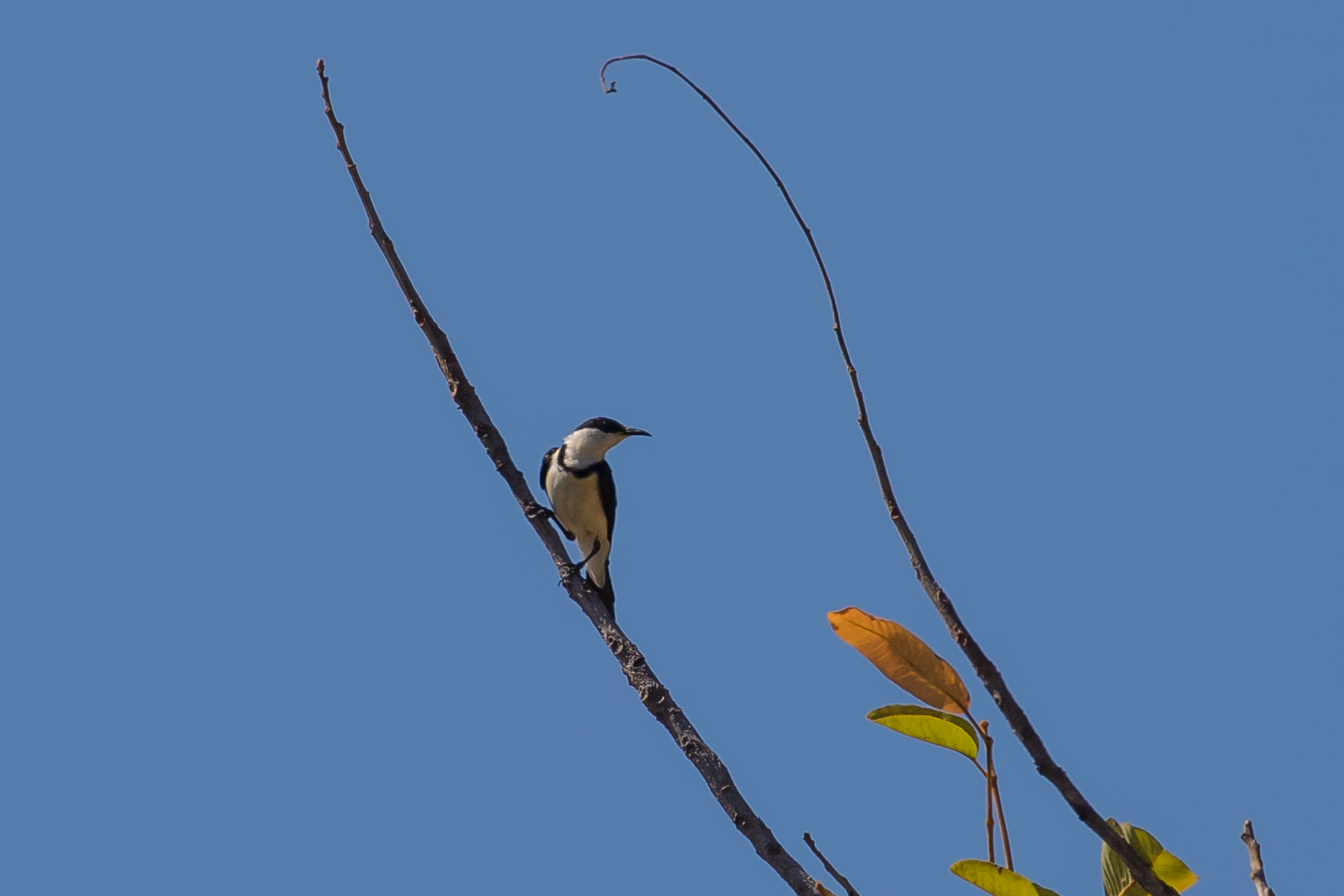
We took lunch at the excellent, highly recommended and suitably named, Finch Cafe in Katherine, then headed west towards Victoria River Roadhouse. We had a few sites to check out on the two hundred km drive. Our first stop was an unremarkable spot that Marc had recommended for Black-tailed Treecreeper. Despite visiting more than a dozen sites where this northern endemic can be found, and driving through 100s of km of suitable habitat we had still not connected. Our stop outside Katherine failed to break the duck, but I did get my first ever Yellow-tinted Honeyeater (another species that we must have driven past 1000s). Getting this Lichenostomus was significant for me because it was the only single-observer bird seen on my 2008 PNG trip. One morning in Port Moresby one of the other punters took a tour of the hotel gardens and saw the only Yellow-tinted any of us had in 4 weeks. Twelve years later I finally clawed back the grip.
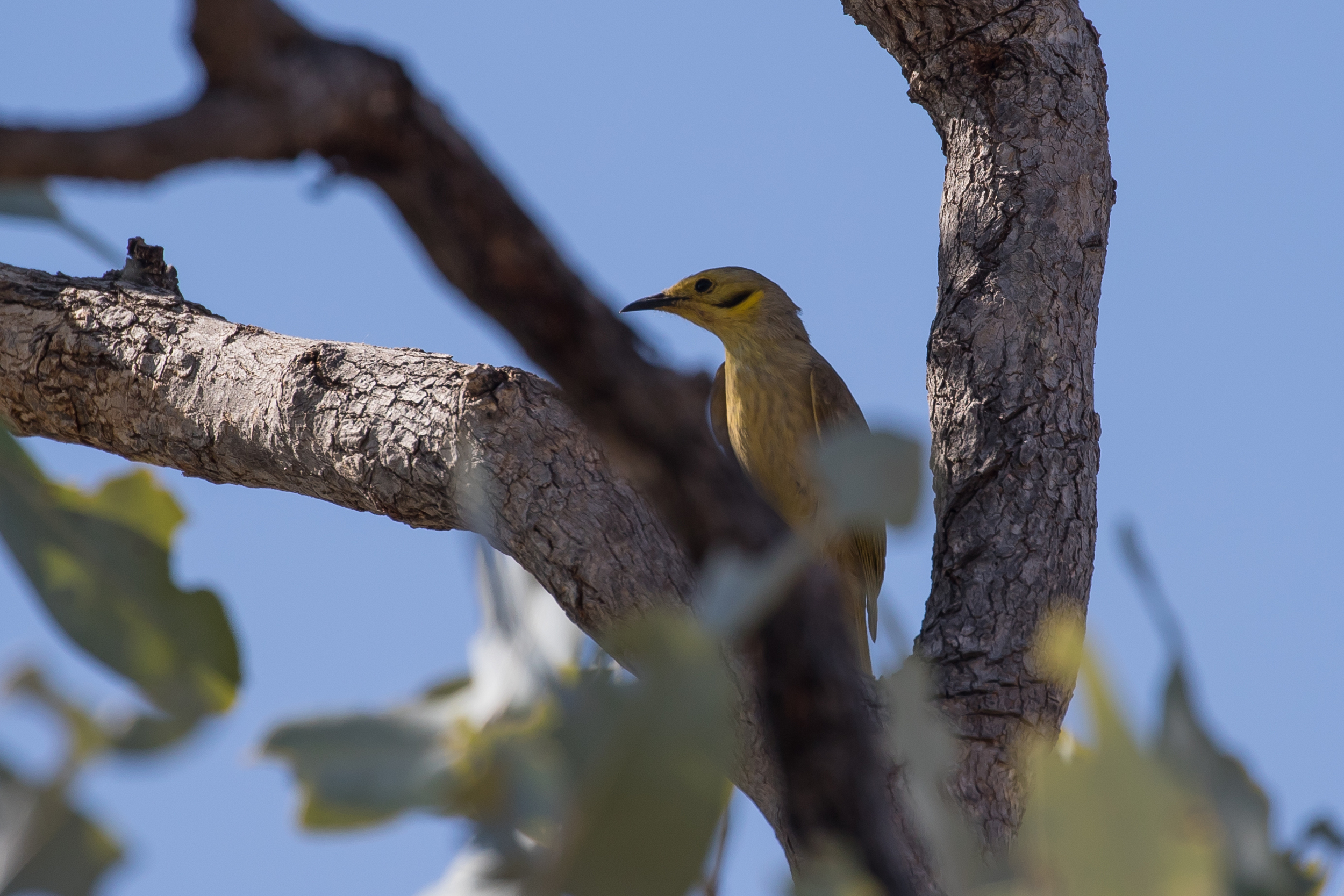
We saw little of note at a few other stops in a hot, unproductive part of the day; best birds noted were some Cockatiel, a few Red-tailed Black-Cockatoo and our first Apostlebirds, all at a farm waterhole about 50km from Victoria River Roadhouse.
It was very quiet at the roadhouse and we were warned that the kitchen was closing at 1830 – they usually cater for people coming to/from WA, but with the border closed to entry there were very few travellers like us, just coming as far as Timber Creek, and escapees from WA had dried up to a trickle. We did notice there was at least one other punter in the campground; the name above ours in the visitor book was SA birder Neil Edwards (he of the gripping Gouldians). Once we’d set our tents we wandered over to his campervan to say hi, then joined forces for a quick trip down to the boat-ramp, another site featured in Dolby and where Paul had seen Purple-crowned Fairywren six years ago.
As we walked down towards the boat-ramp the track passed through tall cane-grass and pretty soon Paul and Neil had found some finches. I joined them (having returned to the car to pick up my phone which I’d forgotten) to find that they were looking at a couple of Chestnut-breasted Mannikins. But as I scanned the tops of the cane grass I noticed another different looking bird. At first I thought this was juvenile Chestnut-breasted, but as I got to see more of it I could see the tail was all ochre-yellow and the head grey. This was not a juv Chestnut-breasted, but an adult Yellow-rumped Mannikin, perhaps the most elusive of our finch targets!
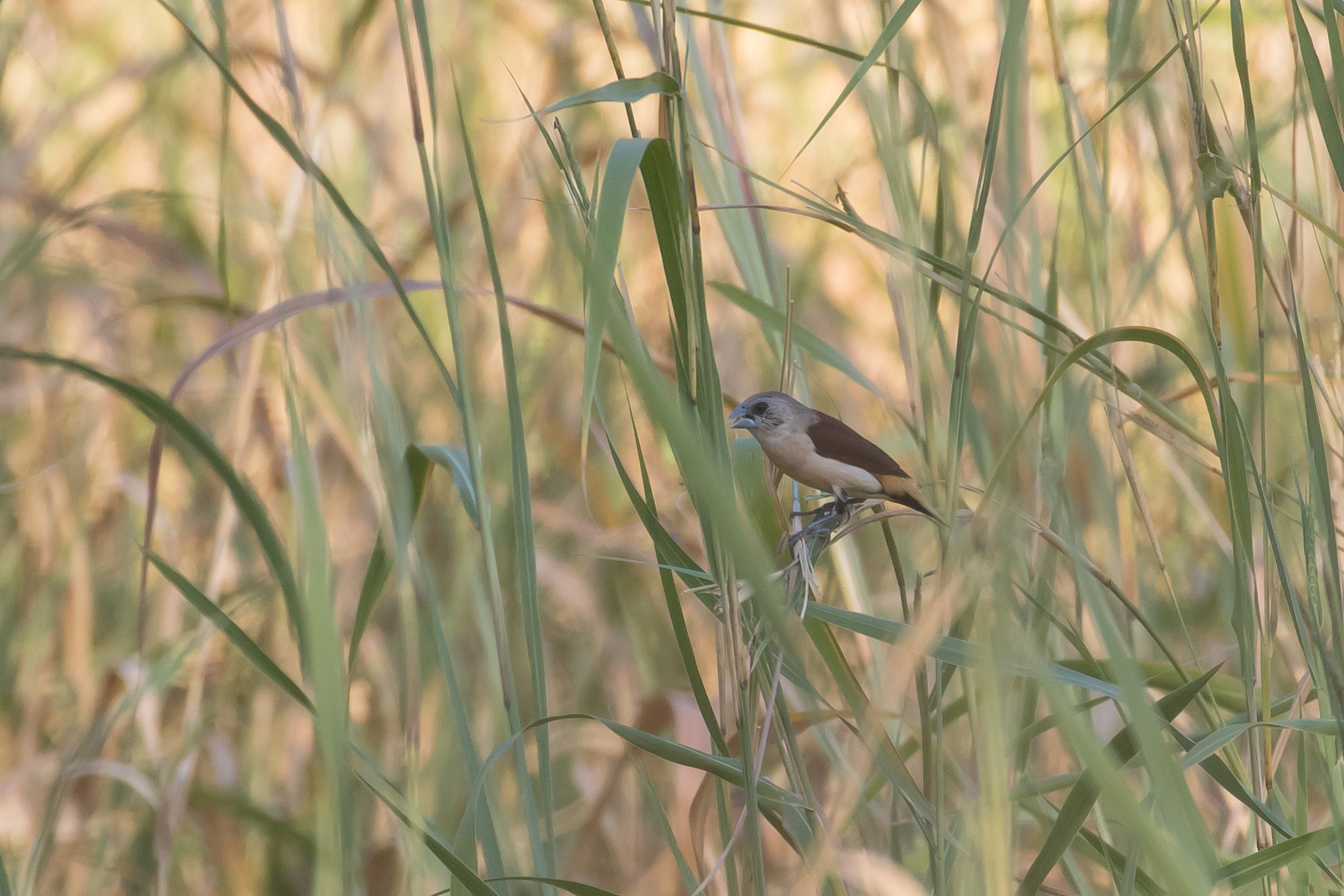
There were no Purple-crowned FW in evidence at first so we pushed our way through some tall cane grass to a small clearing where we were surrounded by head-high grass and I ran a short burst of playback. Instantly a male Purple-crowned Fairywren dashed from the dense cover behind Neil, giving tickable flight views and showing well enough that we could see his stunning purple crown without optics. Over the next few minutes he checked us out, but only at one point did he stay still in the open in the sunlight, and that was for a mere 3-4 seconds. I was lucky enough to get my aim and focus sorted quickly enough to blast off a couple of shots in the narrow window of opportunity but I didn’t hear the shutters of the others fire before he dropped out of sight.
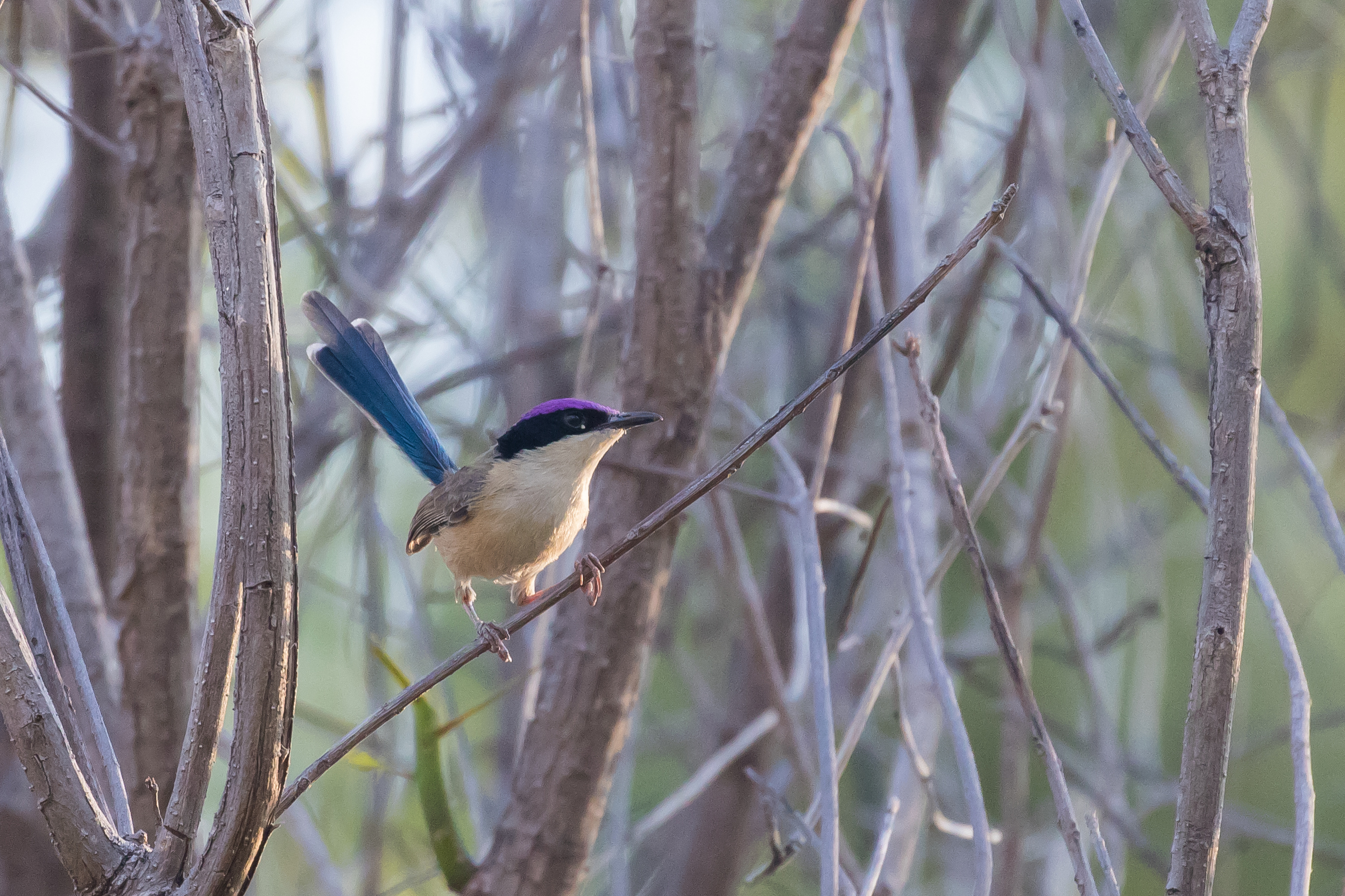
On a high from our double score this evening, resurrecting a hot and largely birdless afternoon, we started back for the road-house. A Spotted Harrier kept us entertained hunting along the roadside for a few hundred metres, and I was happy to wash my schnitty down with some refreshing Great Northern lager. The proprieters had some unwelcome news from a birding perspective. A Barking Owl that had been a regular post-dusk visitor to their fuel pumps over several years had not been seen since a fire ripped through in September 2019.
to be continued…

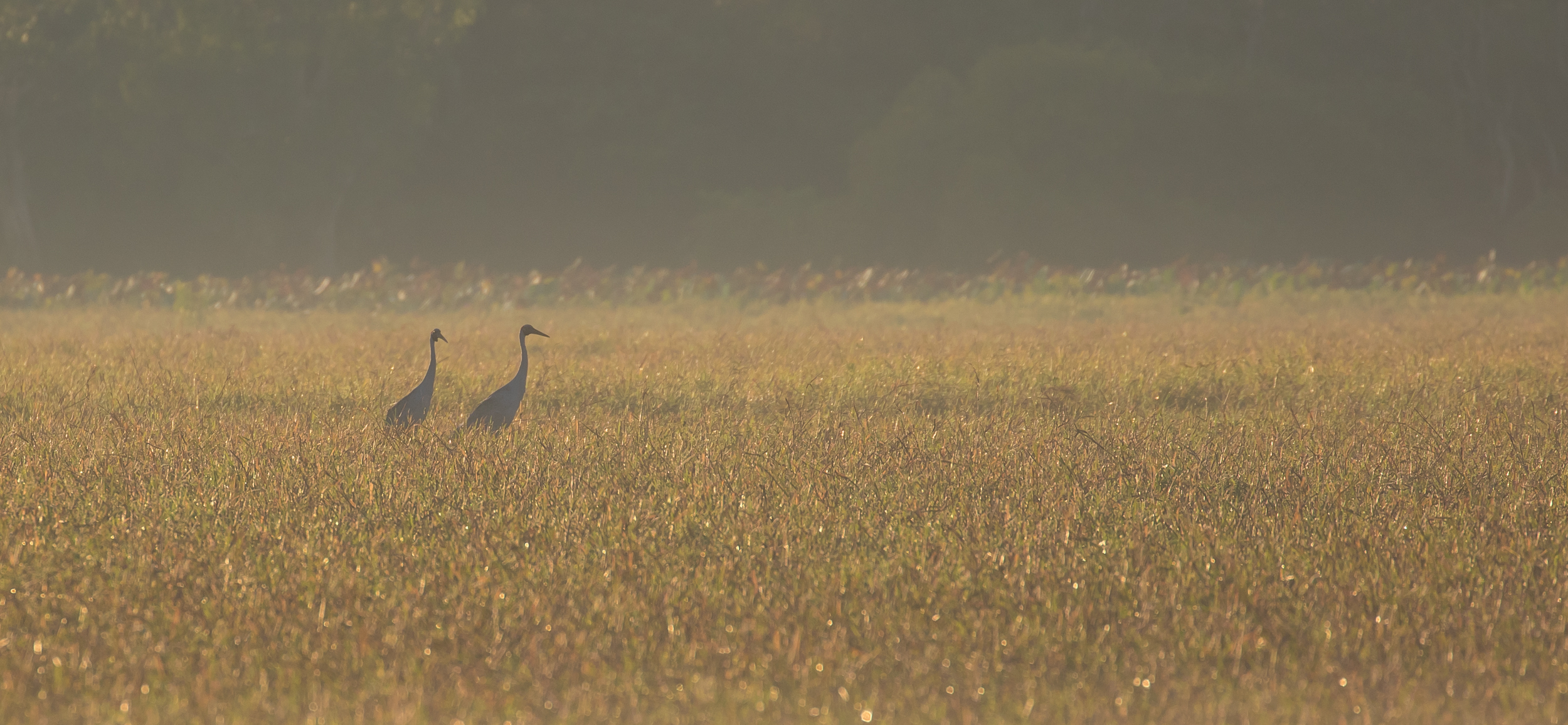
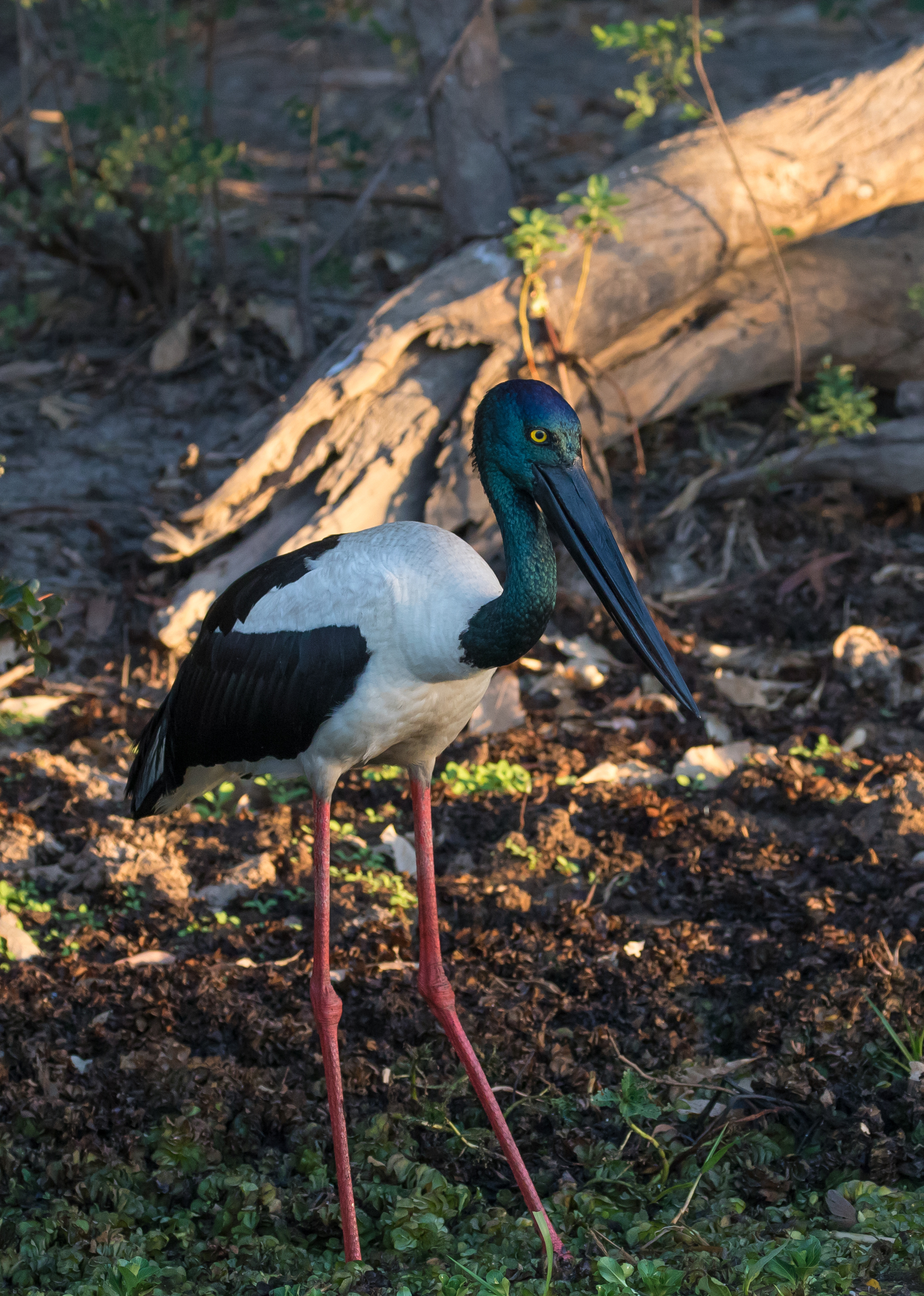
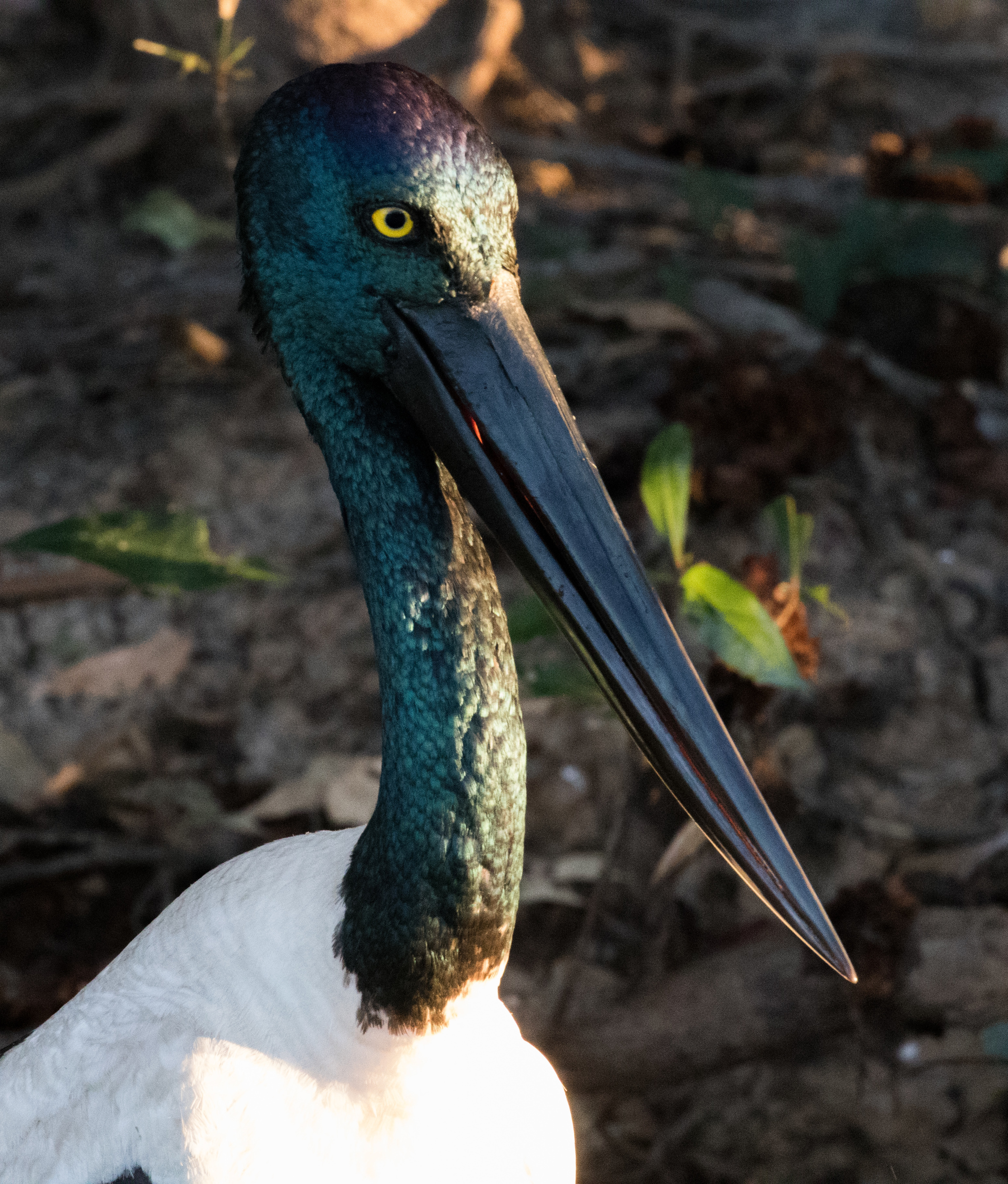
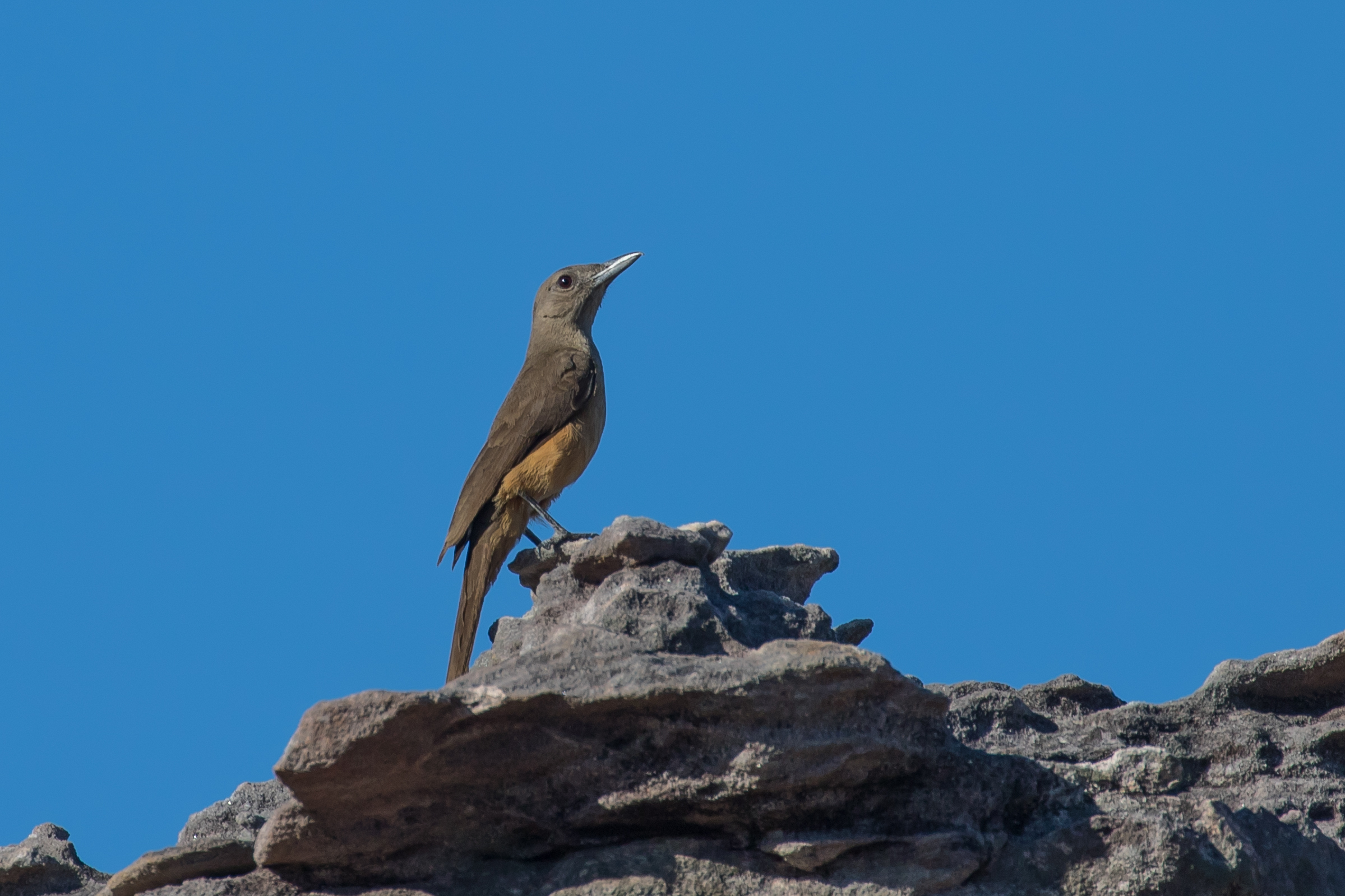
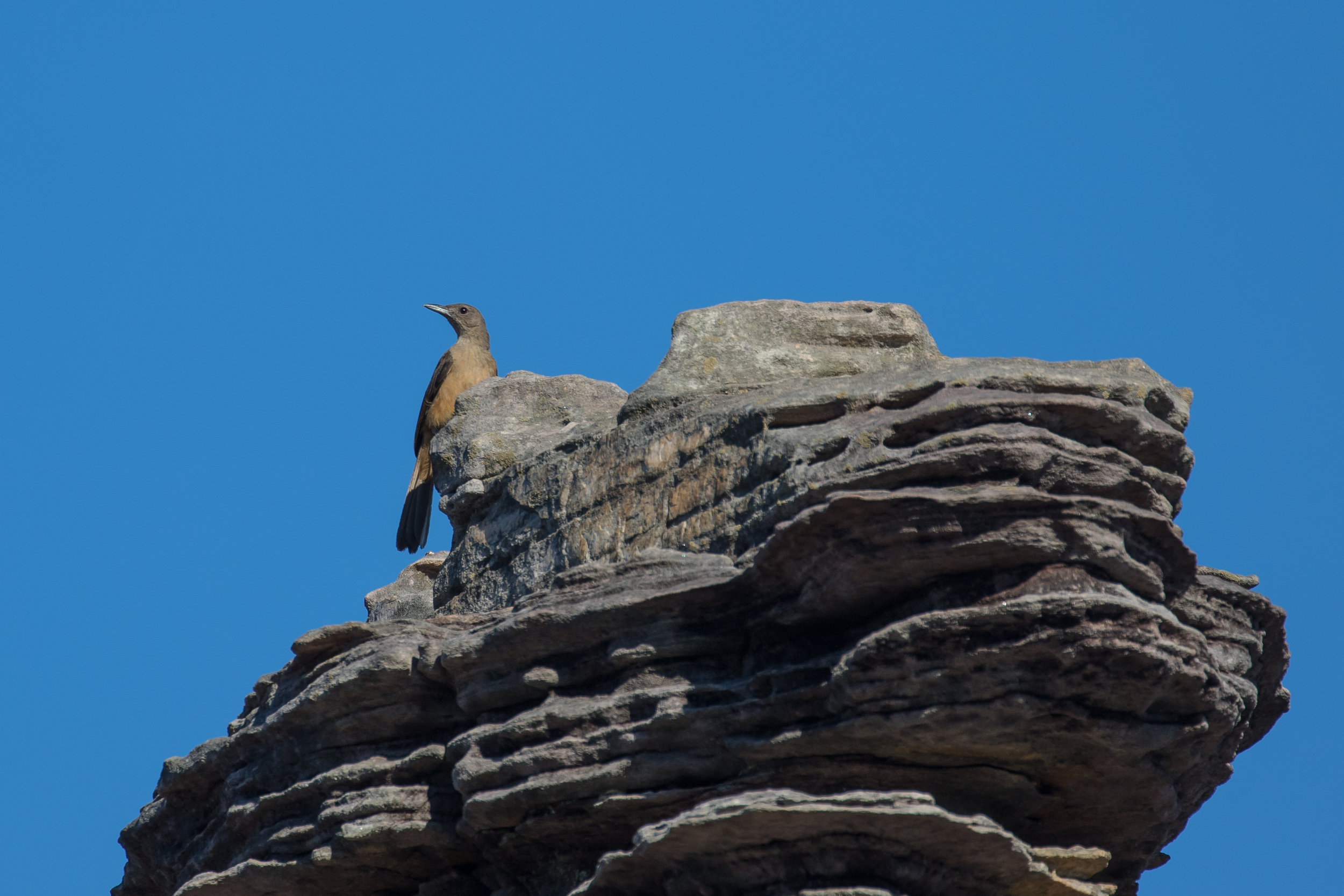
1 Comment
Comments are closed.